Home
Why do young people dislike Kavala?
- Details
- Written by: Gianna Esquivel
- Hits: 712
After having a great beginning in Fanari, this morning we arrived in Kavala, Greece! We left the village environment to arrive in a city and we immediately felt the difference. The pace, the number of people, transit on the streets, the air you breathe, the noise, the buildings, etc. are all signs that are easily readable to the senses. We really like this type of contrast in life and when we travel. To be constantly looking for a difference, even a small one, is our method to avoid boredom. So, we love the conveniences that cities offer. And it's great that the countryside and the villages exist, because they are a great escape when you need a break from the cities. In our opinion, both environments complement each other very well.

We loved the quiet environment of the Greek village Fanari (our previous stop). Let’s see now, what Kavala has in store for us! And let’s find out why young people dislike Kavala.
Where is Kavala?
Kavala (Καβάλα in Greek) is located in northern Greece. You will easily find it on the map following these references:
The city is across Thasos Island.
Based on Google Maps calculations, it is:
- 155 km (1 hr. 50 min.) east of Thessaloniki.
- 40 km (45 min.) southeast of Drama.
- 54 km (50 min.) southwest of Xhanti.
- 149 km (1 hr. 45 min.) west of Alexandroupoli.
- 320 km (4 hr. 20 min.) southeast of Sofia, Bulgaria.
A Glimpse of Kavala’s History
About Kavala, history has been traced until prehistoric times. Through time, this cute and hilly city has had different names, Neapolis is its ancient name, Christopolis (Byzantine), and Kavala (modern). Let’s go through some historical highlights of Kavala to understand a bit more about the architecture, monuments, and attractions you can visit nowadays.
First of all, let’s say that in ancient times, two important cities existed in the current area named Municipality of Kavala: Neapolis and Krinides (later Philippi). Keep this in mind, because the history of both cities is too tied and explains many things about the current Kavala.
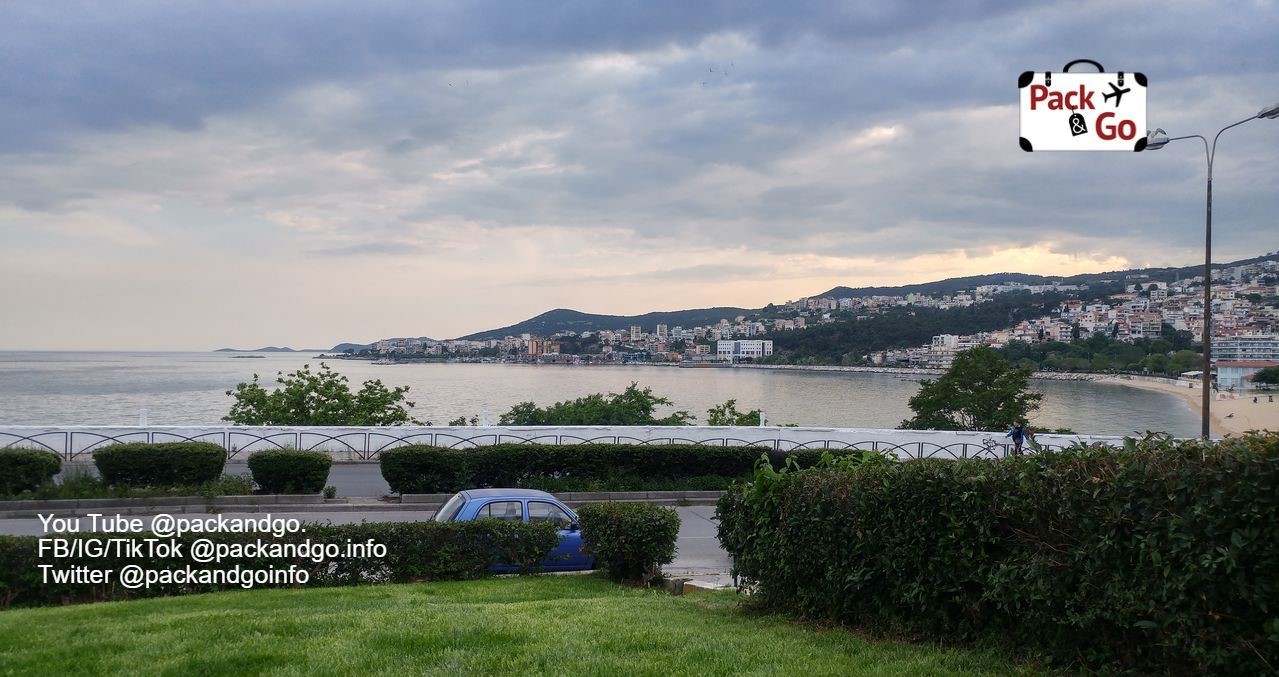
- Kavala’s origin. In the context of long wars against the Thracian races, Neapolis (“new city”) was founded by habitants of Thassos in the 7th century BC. Neapolis thrived as an important trading center due to its strategic location and natural harbor.
- Roman Philippi. The Battle of Philippi took place close to Kavala (42 BC) and marked a significant turning point in Roman history. This meant the end of the Roman Republic and paved the way for the Roman Empire. Philip II of Macedon (father of Alexander the Great) established the city of Philippi, which through time got into a thriving Roman city.
- The visit of the Apostle Paul. It happened in the first century AD. The Apostle’s mission was to spread Christianity through the region. He established one of the earliest Christian communities in Europe, built the first church in Philippi (nearby Kavala), and baptized the first European Christians.
- Byzantine period. Christopolis developed as a key administrative and commercial center. The city was fortified, and several Byzantine monasteries and churches were constructed, like the Panagia Church, transforming the image of the city.
- Ottoman Rule. Ottomans ruled Kavala in the 14th century and kept control of the city for several centuries. During this time, Kavala grew significantly and became a strategic trading hub connecting the Middle East and Europe.
- Tobacco. During the late 19th and early 20th centuries, Kavala was a big player in the tobacco industry. Tobacco’s cultivation and export made the city prosper and brought merchants from around the world. Many tobacco warehouses, called "koulouria," were built at this time.
- Greek War of Independence (early 19th century). Kavala was a point of revolutionary activity where different acts of resistance and heavy fights against the Ottomans took place.
- Liberation and Union with Greece. Kavala got its liberation from Ottoman rule in 1912, during the Balkan Wars. In 1913, it officially became part of the Kingdom of Greece.
- Jewish Heritage. Kavala hosted a wide Jewish community for centuries and the architecture of the Jewish quarter, also called the Synagogue neighborhood, is a living proof of that. The synagogues, schools, and other buildings are traces you can still find today.
- Modern Kavala. Bulgarians were a constant threat since the Byzantine era. During the early 20th century, Kavala was occupied three times more by Bulgaria. In 1912, during the First Balkan War, Kavala was liberated soon after, in 1913 when the Second Balkan War was on. Later World War I ignited and in 1916, Bulgaria took over Kavala again. To get liberated from them was harder this time, but finally, in 1918 Bulgarians got expelled. The third Bulgarian occupation took place in the war of 1940-1941 when Greece was occupied by the Axis Powers. The invasion was led by nazi Germany and supported by its Bulgarian ally, which possessed Kavala until 1944.

Lighthouse, Kavala, Greece. Photos by packandgo.info
A long war history preceded the development of Kavala into a modern city. Now, it keeps its ancient importance as a strategic seaport and it is one of the largest cities of Macedonia included in the wide menu of cool destinations that Greece offers to tourists worldwide.
| Follow PackAndGo.info at: | |
| YouTube | @packandgo. |
| @packandgo.info | |
| X | @packandgoinfo |
| @packandgo.info | |
| Bluesky | @packandgo.bsky.social |
| TikTok | @packandgo.info |
What to do in Kavala? What to visit in Kavala?
Beaches of Kavala
Kavala is a beautiful hilly city, but we can’t deny that beaches make it even more attractive. You know, those Greek clear waters you see in every pic on the Internet. Sandy beaches, a long coastline, beauty all around, and easy-to-reach tavernas, what else do you need? During our visit (May 2023), we had a few rainy days, but several sunny ones so we enjoyed a lot jumping into the waters of Kavala beach to start, and later, in the Tosca, Batis beaches and more. You can explore km by km of the coast and find awesome spots on the beach where to have a very relaxing time! We were moving 4km, 5km, 8 km and the findings were awesome! (LINK a nea iraklitsa, etc.) During Summer, the beaches get full of beach bars, umbrellas, and sunbeds. Exactly now, the beaches were clean of those facilities and it was perfect!
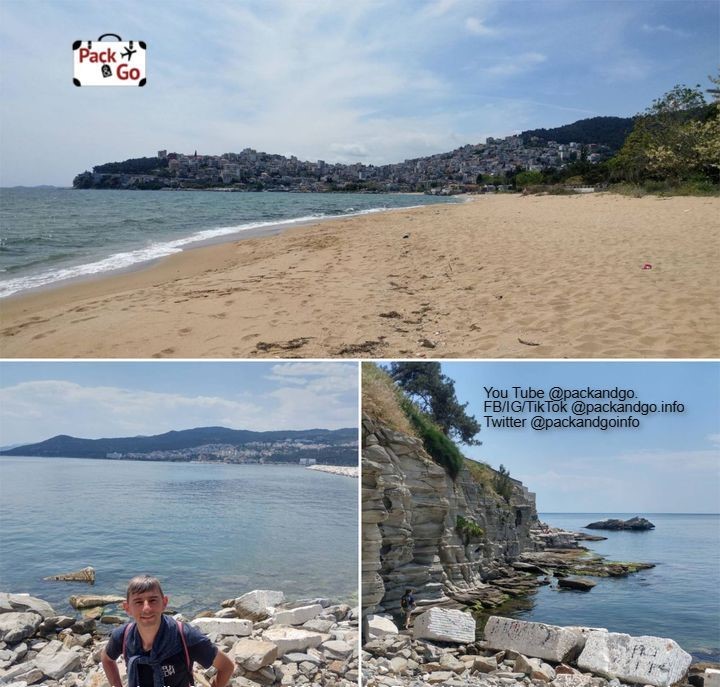
The Castle of Kavala or Kavala Fortress
When you arrive in Kavala, you will spot the castle on top of a hill overlooking the city. It dates back to the 15th century. On the first days, we skipped the challenge hahaha. We thought, “It looks awesome from here (down)” hahaha. We were lazy, it’s true! But we knew that sooner or later, we would face the challenge of walking up to visit it. And that day, was today! We walked heading to the Old Town of Kavala. Honestly, it is a moderate climb, but we did it during a very sunny day (May 2023), so it demanded some breaks and drinking water. The effort for sure feels double if you go in Summer when it is much hotter.
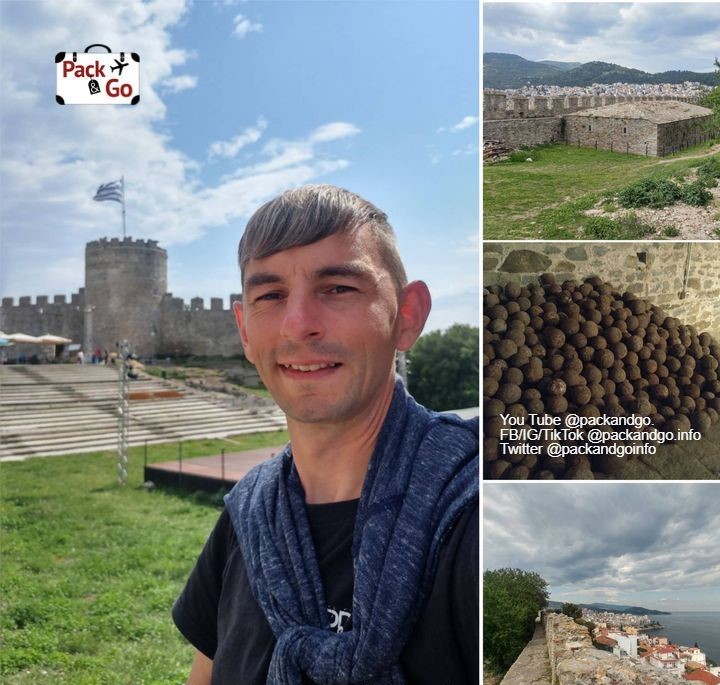
After 45 minutes (breaks to take pics and breath included), we reached the crest of the hill, where the castle is. The Castle of Kavala is also called Kavala Fortress, and this last name suits it better because what you will see there is the strong walls and the tower of a fortress, plus the ruins of the food and ammunition store that became a prison during some time. The bricks, granite stones, and marble of the fortress walls suffered attacks from Byzantines, Venetians, and Ottomans. Views from there to the city and the Aegean Sea are splendid. We recommend you walk up there. You can take a taxi but come on, no pain, no gain! Hahaha.
There is an entrance fee of € 4.50 (May 2023).
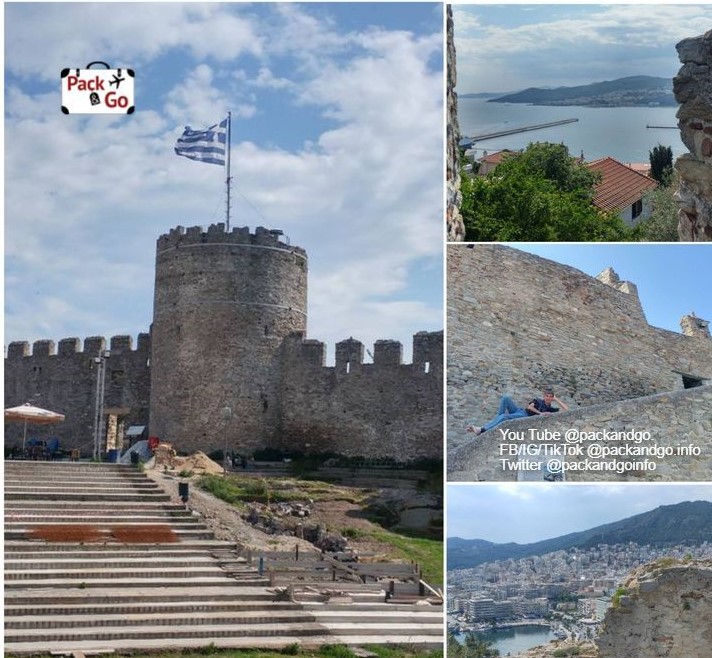
Old Town of Kavala or Panagia’s District
If you visit the castle, you will be in the Old Town of Kavala and vice versa. It is a nice place to visit. Walking around is the best way to enjoy it since the streets can get very narrow at some moments. But in this area, the present and past interact daily. While walking, you will discover landmarks, old houses, and monuments, but also modern people going to school, cooking, washing clothes, or having a beer in a tavern. The Old Town is not kept as a museum. It is a place with a deep history where current people live a regular life.
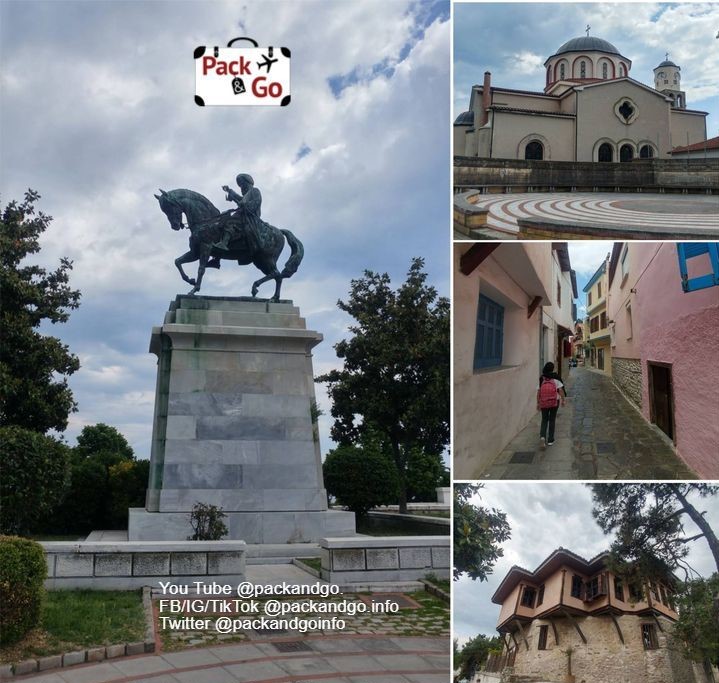
Neoclassical buildings, colorful houses, cobbled streets, cute wooden balconies, blooming gardens, and traditional taverns await there for your visit. Karaoli Square, the Imaret which is a kind of complex common to find in Ottoman cities and a trace of the Ottoman presence in the area (currently, a hotel); a monument and the house of Muhammad Ali (nowadays, a museum), who was born in Kavala and created the Imaret; the Holy Church of the assumption of Holy Mary which in the past was a monastery operated hiddenly during the Turkish occupation, the lighthouse, where you can enjoy panoramic views, beautiful sunsets, and even the Thasos island during clear days! If you are looking for a romantic place, this is it!
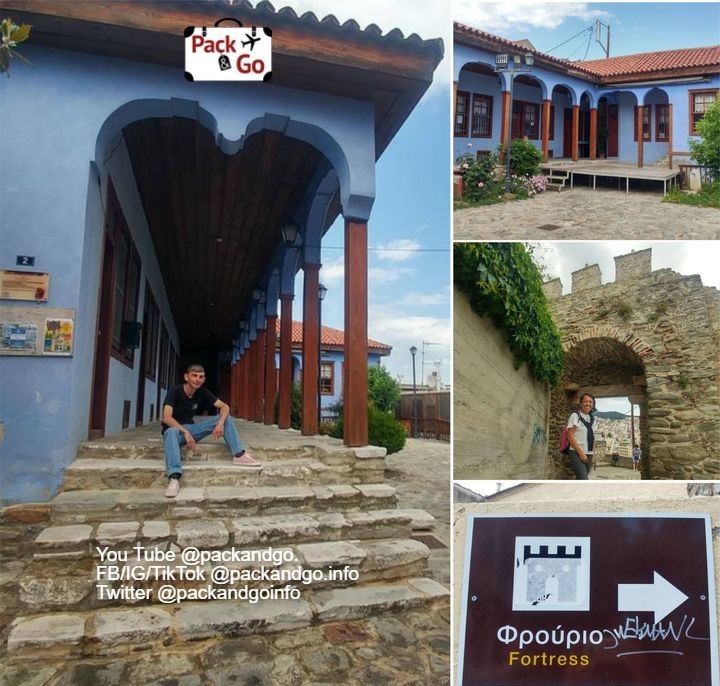
Kamares, the aqueduct of Kavala
It is a very well-preserved landmark, originally constructed by the Romans to ensure the water supply for the city. Its arches and the whole structure are visible from different points of the city.
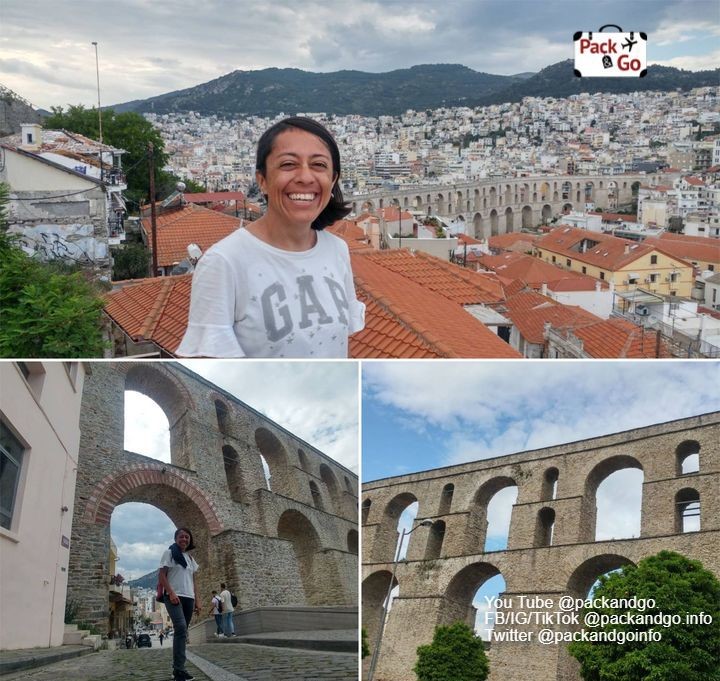
Kavala’s Port
We loved to walk around the port. We got interested in watching fishermen working on their boats. It is a very pleasant place to go around and get more pics of the hilly city, the fortress up, and its surroundings. Tourists but also locals gather in the nearby taverns, cafés, and benches. It is a cool place to meet Greek people if you feel like it.
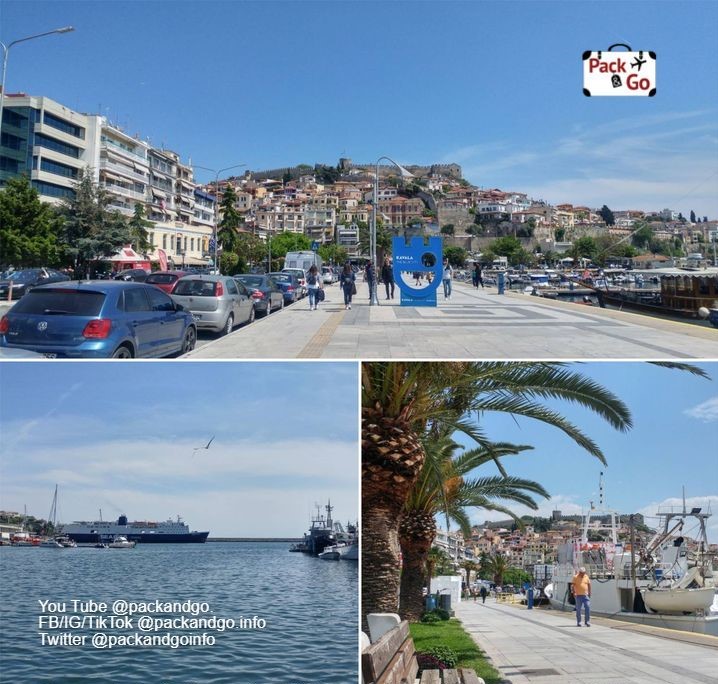
Municipal Park of Kavala or Alistrati Park
The park is close to the center and it is a very nice escape from the streets of the city. During sunny days, it was a cool place to take a break after exploring the city. You can just sit on a bench there, choose a shade, relax, and recharge energy to keep going around Kavala. It is a cool place, that picnic lovers shouldn’t miss!
You may also like: Top 5 parks in Budapest for picnic lovers
Taverns, restaurants, and cafés
You will find taverns and cafés all around Kavala. Greek seasoning is very tasty, so either if you are a meat lover or a veggie, there is a dish you can enjoy. Kavala’s cuisine blends traditional Greek flavors with influences from the nearby Aegean Sea and the Balkans.
Drinking a coffee while enjoying a nice view or chatting with friends is a nice way to spend time here.
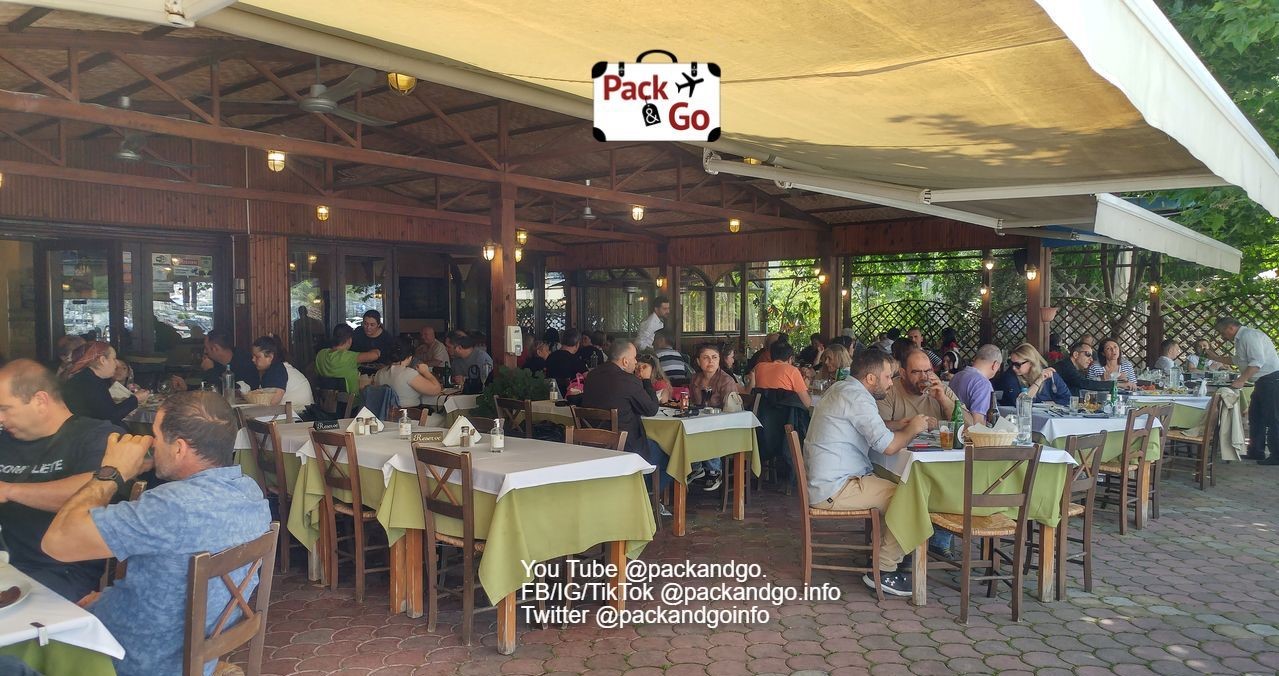
Philippi, archeological site
If you feel like going a bit out of Kavala, drive only 16 km northeast (24 min.) and you will reach Philippi, a popular archeological site. There, you will see the well-preserved ruins of the theater that date back to the Hellenistic period, the forum, and some early churches. Remember the visit of the Apostle Paul to Philippi to spread Christianity.
Art galleries and museums are also a choice but this time, we will leave them for you to visit and tell us your opinion hahaha.
Why do young people dislike Kavala?
As you see, Kavala is a modern and comfortable city to visit. It has a fast pace, you see people going around all the time, to work, to school, etc. But still, it is not a crowded city. Based on the last census results (2021) published by the Hellenic Statistical Authority (ELSTAT), the population of Kavala is 66,376 inhabitants. When we compare with the population of Mexico City where we lived some time, there is a big difference between sharing space daily with millions or with only thousands. Kavala’s population is still something you can handle without feeling overwhelmed. Transit on the streets sometimes gets very busy, so you can better walk or get a bicycle. The choices are many when it comes to taverns, all types of shops, entertainment, etc. Besides being a city with all the amenities, it has awesome beaches and that is a super bonus! So why do young people dislike Kavala?

The answer was explained to us directly by different young guys we randomly met while visiting the city. Greek people are very kind, fun, and willing to have a nice chat with you. We loved they are generous with their time and words, meaning, they like long and straight conversations hahaha. Sometimes, when you meet shy people or people reluctant to speak about some matters, conversations go only in monosyllables and it is too hard to get interesting stuff.
Why do young people dislike Kavala? Well, as tourists we miss some factors that make a difference for people who live in the destination we visit. Kavala’s youth enjoy a lot the Summer and its nice vibe. Lots of tourists arrive and with them, more job opportunities get opened and it gets more fun too. But considering that is seasonal, they have 3, maximum 4 active and cool months every year. When Winter arrives, the most fun part of Kavala goes to sleep, beaches get empty, the sea is cold, and good job opportunities are less. That is very disappointing for young people trying to succeed in life.
The economic challenges Greece has faced in recent years, together with high unemployment rates and limited chances for young people, lead them to some level of frustration and desire for change. Many young guys of Kavala reckon the future they want is either in a bigger city, they mentioned specifically Thessaloniki, or somewhere abroad, but not in Kavala.
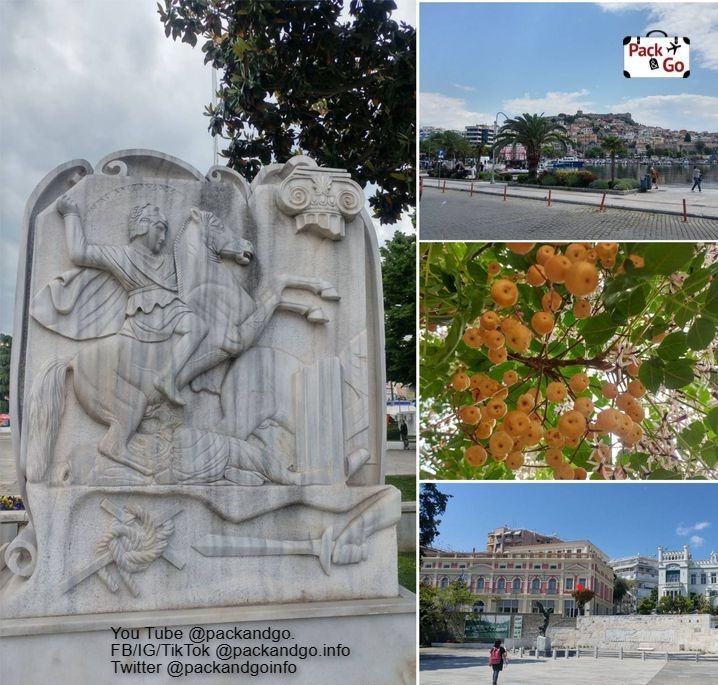
It is very interesting to chat with local people. When they talk with you, it is like they draw the curtains to show you their reality, their daily goals, and concerns; behind the scenes of a city that on the surface looks just great. Seriously guys, thanks again for sharing your time and thoughts with us!
So dear Pack and Goers reading this blog, if you have the chance, to talk with people, Greeks have really interesting stuff to share and travels are also about learning. Monuments and archaeological sites teach a lot about history, but today's people have a lot to say. And right now, they are the ones writing the future of the city.
Disclaimer: these comments may not represent the opinion of all of Kavala’s youth, but they were frequently expressed by young people between 16 and 24 years old.
Conclusion
We had an awesome time in Kavala, Greece. We recommend this city as a cool destination to visit for everybody, no matter the age, there is something for you. There is history, culture, natural beauty, tasty food and beverages, a nice vibe, cool people, everything to have a great time.
If you are thinking of living in Kavala and you are young or you have young kids, you should check more about the opportunities for young people to develop and succeed first. If you are an adult, digital nomad, or retired, go ahead and enjoy Kavala! Perhaps, this Greek city is the retirement destination you never thought about!
We are enchanted in Greece so we will stay longer! Discover the next stop of our 2023 tour, following packandgo.info
| Follow PackAndGo.info at: | |
| YouTube | @packandgo. |
| @packandgo.info | |
| @packandgoinfo | |
| Bluesky | @packandgo.bsky.social |
| @packandgo.info | |
| TikTok | @packandgo.info |
You may find interesting also:
It is official, Fanari has been occupied by Bulgaria!
Please, do not visit the beaches near Kavala City!
Keramoti: The Beach Town You’re Not Visiting—And It’s Better Than Santorini!
Thasos, Greece: Don't Fall for the Hype! Read the Truth!
Alebrijes, meet these fantastic and colorful Mexican creatures!
- Details
- Written by: Gianna Esquivel
- Hits: 699
I have seen alebrijes around since I was a kid. My grandma used to have a big and colorful collection. When I was afraid of the darkness and I couldn’t sleep well, she brought home a couple of alebrijes to give me courage and strength. A tiger with eagle wings, so worse case I could fly away from the danger. And a fish with claws and an owl head, to be smart to deal with my nightmares or bad ghosts, and agile to swim away from them.
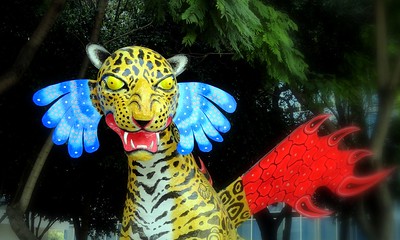
Those alebrijes were on my nightstand long time. For me, they represented my grandma in the shape of those exotic figures protecting me while sleeping and giving me the necessary strength to stand by myself. Those lovely alebrijes moved away only when my grandma died. I was very sad. She and her alebrijes gave me a lot of good stuff for years. Since we couldn’t be together anymore, alebrijes could take care of her and be nice company.

Alebrijes are a beautiful Mexican tradition and they have become internationally popular. If you are ready to Pack and Go to Mexico, this article can prepare your magical encounter with those fantastic and colorful Mexican creatures.
| Follow PackAndGo.info at: | |
| YouTube | @packandgo. |
| @packandgo.info | |
| @packandgoinfo | |
| @packandgo.info | |
| TikTok | @packandgo.info |
What the Mexican alebrijes are?
Alebrijes are Mexican crafts that recreate figures of hybrid animals. That is, each figure combines physiognomic elements of different animals. The craftsmen are mainly based on real animal features, but their combination results in a fantastic, non-realistic animal figure. In practical terms, they are used mostly to decorate people’s homes.
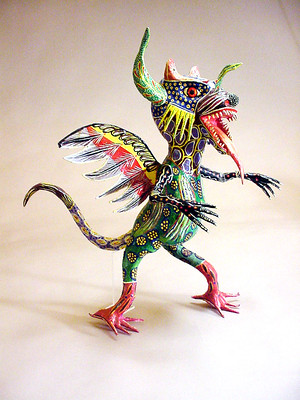
There are different animal feature combinations, sizes, from a little version not bigger than your hand to monumental versions up to 3 or more meters high. These last can be seen in exhibitions and parades.
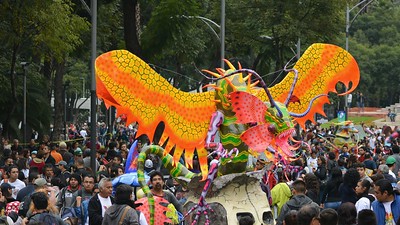
What is the story behind alebrijes?
The story behind alebrijes is not too old and it’s an interesting one. This level of fantasy and creativity was the result of a human illness.

Alebrijes were created by the Mexican handicraftsman Pedro Linares López in 1936. Pedro Linares was born in 1906 in Mexico City. He was “cartonero”, meaning a man dedicated to papier-mâché sculpting of piñatas, masks, Catholic saints, and more Mexican figures. This is a traditional and popular handcraft in Mexico and it’s called “Cartonería” in Spanish. The kind of texture the paper gets after the sculpting process refers to the paperboard’s one. It’s also called “cartón-piedra” (paperboard-rock) due to its final rigidness.
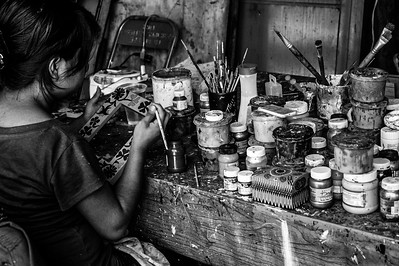
When Pedro Linares was thirty years old (1936), he got a severe illness that produced high fiber for a long time. While being unconscious, he had a dream or a hallucination, in which he was strolling around a weird forest. There, he found different strange and colorful creatures like a winged donkey, a rooster with bull horns, and a dog-headed lion. They all were yelling the same word, “alebrijes”.
Against the initial medical prognosis, he managed to heal. He got back to his artisan workshop and then he decided to replicate the fantastic creatures of that dream. The result was several exotic chimeras visually very attractive. Pedro Linares's creation was a success and soon, more handicraftsmen imitated his alebrijes using the same technique, “Cartonería” or papier-mâché sculpting.

Even the famous painters Frida Kahlo and Diego Rivera requested Pedro Linares to create alebrijes for them. This collection is currently available in the Anahuacalli Museum in Mexico City. In 1975, Judith Bronowski, a British filmmaker produced a documentary about alebrijes and his creator. Pedro Linares never imagined that a hallucination could solve his economic problems and change his life in such a way. His alebrijes became a great contribution to Mexican popular art.
What is the origin of Oaxaca alebrijes?
The original alebrijes were created in 1936 by the Mexican handicraftsman, Pedro Linares López, in Mexico City. As we already explained, his alebrijes got really popular all around Mexico and even abroad. Handcrafting is a common activity all around Mexico. Techniques, materials, and styles vary based on the town, region, or state of the Republic. When the alebrijes succeeded, handicraftsmen from Oaxaca and other Mexican states saw the opportunity and replicated Pedro Linares's alebrijes. With time, they developed their versions. In Oaxaca, handicraftsmen started sculpting alebrijes using their traditional copal wood, instead of paper and the papier-mâché technique.

People liked the result and more handicraftsmen in Oaxaca turned to alebrijes as the main product or included them in their variety of figures. After, they added a mystic factor to their alebrije version. They said they got the inspiration to create them on the nahuales, a pre-Hispanic myth that involves animals as protectors or guardians of humans.
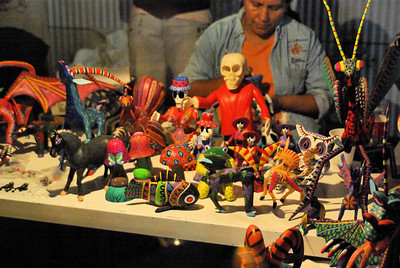
What is a nahual?
Nahual is a supernatural entity that is documented in different stories from the pre-Hispanic times. It had been pointed like a witch, evil, or a guardian. In Oaxaca, a nahual is a guardian every human has. And this guardian is an animal.

Old people from Salina Cruz, La Ventosa, San Vicente de las Piñas or Huajuapan de León in Oaxaca have explained that a nahual is the animal with which you have a supernatural relation since you get born. It is like your twin in an animal version. It becomes your protector forever. And with time, you should develop the skills of such animal, and even a sort of therianthropy, meaning to be able to transform in that animal. The animal could also transform into a human.

Others in Oaxaca tell a darker story. A nahual can also be an entity that tortures souls during their trip to their altar. It is especially evil with the youngest souls. Some rituals are required for humans to help those souls to reach their destination safely.
What is the myth of the nahual in Oaxaca?
In Oaxaca, the myth of the nahual says that every newborn should get his or her nahual. To get it, once the mother gave birth, her baby should be taken to a forest or a field to be left in a quiet spot there with the close surveillance of the parents.

Then, they had to wait for the first animal to get close to the baby. This animal would be the baby’s nahual. His or her guardian for life. And with time, due to this supernatural bond, the human could develop the animal’s skills and the ability to transform on it and vice-versa.
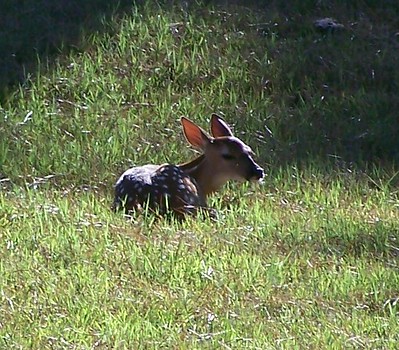
The dark version of the myth says a nahual is an entity from the supernatural world that tortures souls during their journey to their altar. It is said that the nahuales come from humans who were not good in life. So, when they die they are transformed into permanently hungry and thirsty beasts.

Nahuales are said to be crueler to young souls. For this reason, people usually include a guard dog, or itzcuintli, on their altars to protect them and ensure their safe arrival at their destination.
Conclusion
Alebrijes are fantastic and colorful Mexican creatures. Now you know the story behind their creation. If you are going to Mexico, don’t miss the chance to get some! They can get your heart just like my grandma's alebrijes did with me or if you like to believe in supernatural guardians, well, you’ll have an extra hand, just in case. They are a beautiful tradition that it’s worth meeting and sharing with your loved ones!
Share your experiences and favorite alebrijes with us.
| Follow PackAndGo.info at: | |
| YouTube | @packandgo. |
| @packandgo.info | |
| @packandgoinfo | |
| @packandgo.info | |
| TikTok | @packandgo.info |
Thasos, Greece: Don't Fall for the Hype! Read the Truth!
- Details
- Written by: Gianna Esquivel
- Hits: 555
Guys, visiting Northern Greece is going great! This area is much quieter than Athens, Mikonos, and other famous Greek destinations. It is a real and charming relaxation paradise! Today, finally we decided to take the ferry and visit Thasos Island. It will be our first time there. Many people have recommended visiting the northern “Aegean’s Jewel”, especially a Dutch friend who used to go there every year to enjoy the beaches and buy wine. Why? We don’t know yet! Is it just a Marketing exaggeration? Let’s not delay the exploration of Thasos, Greece!
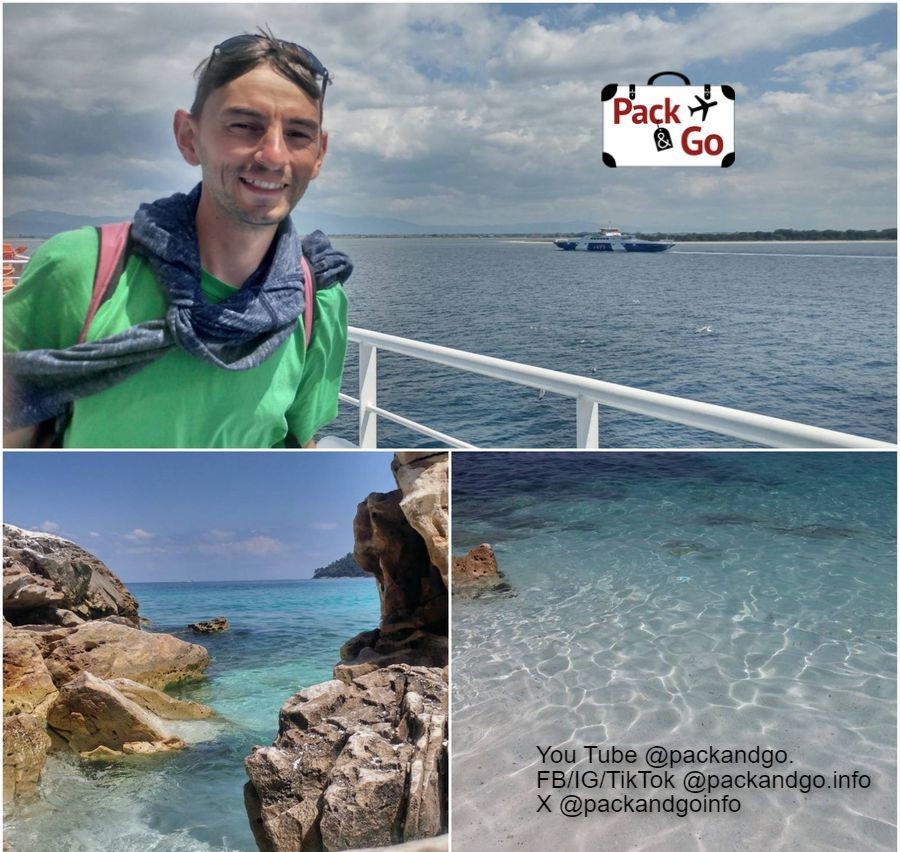
Where is Thasos Island?
Thasos is the northernmost Greek island in the Aegean Sea. Its capital town is Limenas and the island belongs to the Kavala prefecture. Take a map and look for Kavala or Keramoti as a reference. Thasos Greek island is exactly in front of them. In figures, it is ten kilometers from the southeast of Kavala’s seaport. Its proximity to the mainland makes it easily accessible for locals and tourists.
How to reach Thasos, Greece?
Easy! Take a ferry. This transport is available all year round, with departures every 30 or 45 minutes, approximately. Based on the season and demand, you can find more or less available schedules.
We boarded the ferry together with on-foot tourists and people with a car. If you go on foot, the ticket is 5 € per person (one-way ticket). If you take your vehicle, you pay a ticket for every passenger and a fee for the car. The vehicle fee varies based on its size. To take our car, we paid 20 € (one-way ticket).
How long is the ferry crossing to Thasos, Greece?
Approximately 30 minutes. This is the duration of the ferry trip considering you leave from Keramoti to Limenas. You can also take a ferry from Kavala to Skala Prinos, but that journey takes longer, around one hour and fifteen minutes.
We haven’t boarded many ferries and perhaps that has kept the experience fresh and exciting for us. We like it! Taking the ferry during the day guarantees beautiful views and a relaxing crossing.
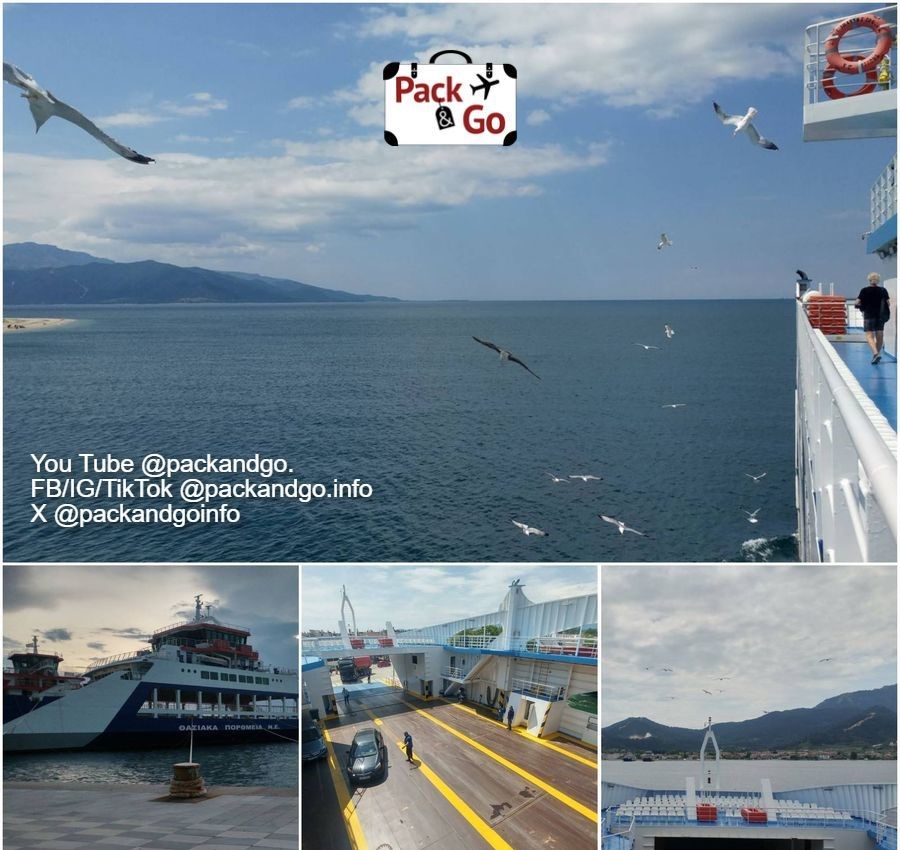
If you take your car, we recommend you to be careful especially when arriving at the destination. The madness and haste of the passengers frequently overcome the ferry’s crew's instructions to keep the order. Everyone wants to be the first to get off the ferry, no matter how many cars are in front of them or whether a foot passenger crosses their path. We were there in the low season (May, beginning of June). It can go crazier during the peak season.
What is the origin of the name Thasos?
Based on the myth, Thasos Greek island was named after Prince Thasos, one of the first settlers on the island, son of Poseidon -or a Phoenician king, in other versions-, and leader of the Phoenicians. Thasos arrived in this land while searching for his sister, the Greek goddess Europa, who was lost. The island's beauty enchanted him so he settled. We could easily fall into that temptation too!
Thasos, Greece, a bite of history
First of all, know that Thasos was not an island. Thousand of years ago, it was part of the mainland, but geologic changes transformed it into an island.
Thassos, Greece, was initially settled by the Phoenicians. Over centuries, it experienced a turbulent history with numerous wars and battles involving various regimes. Control of the island shifted between the Athenians, Persians, Lacedaemonians, Romans, Latins, and Turks. Finally, during the Balkan Wars, in 1914, Thassos came under Greek control.
| Follow PackAndGo.info at: | |
| YouTube | @packandgo. |
| @packandgo.info | |
| X | @packandgoinfo |
| Bluesky | @packandgo.bsky.social |
| @packandgo.info | |
| TikTok | @packandgo.info |
Thasos has been continuously inhabited since the 7th century B.C. Through time, its inhabitants engaged in various economic activities, some of which remain. Agriculture was the cornerstone, with honey and olive oil being the primary products. Additionally, locals were involved in herding, fishing, and mining operations for zinc, lead gold, silver, iron, and copper, along with extensive lumbering activities. Thassos is also well-known for its marble quarries and wine, characterized by a distinctive apple aroma. Exportation of these resources to Egypt, Italy, and Asia Minor, gave significant wealth to the island. Currently, tourism is essential in Thasos, Greece, economy.
What to do in Thasos, Greece?
Don't fall for the hype, read the truth! These are the activities we enjoyed most while visiting Thasos Island:
Enjoy Thasos beaches
Thasos beaches are stunning and you can choose the best for you. Lively waterfronts or a secluded and beautiful cove? Golden sands, calm shores, and scenic allure are guaranteed wherever you go. You can access Thasos beaches by car or bus and enjoy complete days swimming and admiring the azure waters of the Aegean Sea. At the end of this article, you will see a really wonderful beach!
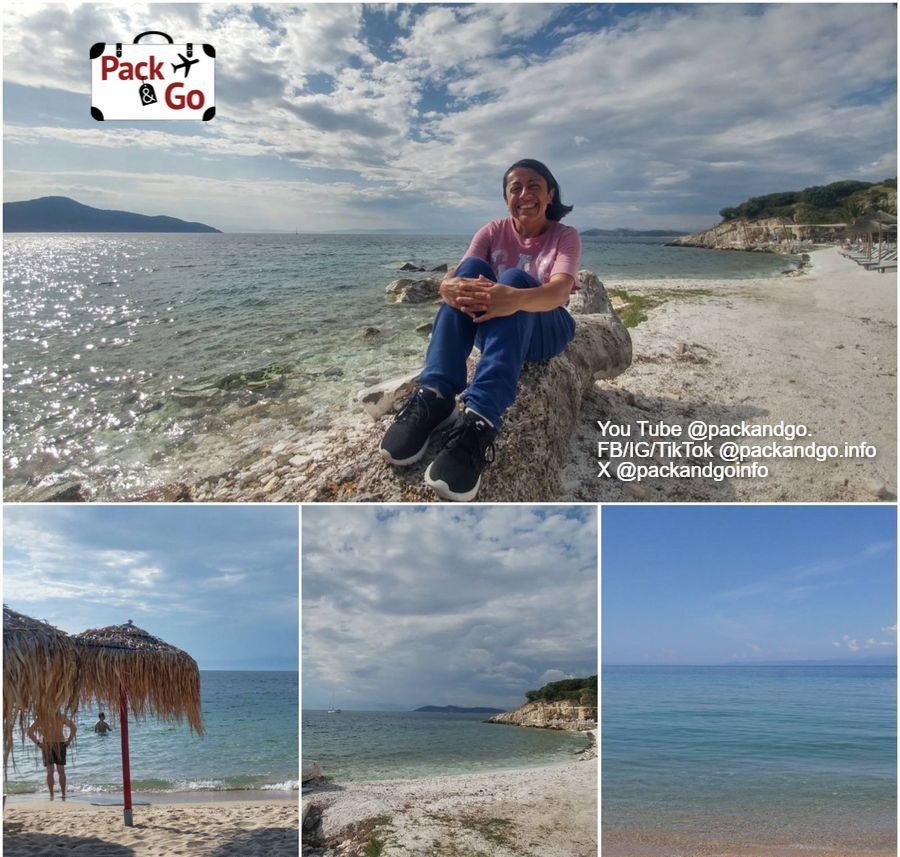
Snorkeling
The clarity of the Aegean waters on Thasos Island is captivating. Snorkeling is a great choice! You can explore the depths from the shore or venture into the depths of the sea (scuba diving).
Taste Thasos, Greece, wines
Our Dutch friend was right! History confirms his opinion about Thasos wines. Being here, we discovered Thasos is one of Greece's premier wine-producing regions. The island's rich vinicultural history was honored in its ancient coins, which feature the head of Dionysius, the god of wine, on one side, and many delicious grape clusters on the other.
The island's winemaking tradition dates back to antiquity, thriving thanks to Thasos’s fertile soil and favorable climate. Today, Greek wines are not the best ranked and it is a bit strange if you consider Greeks have been making wine since around 2000 BC. They have the experience, the knowledge, the climate, and soil to thrive. Anyway, if you are a wine expert you could unravel this mistery. For all wine enthusiasts, know that the island offers a diverse selection of wines to indulge and immerse in this tasty and ancient tradition. Good or bad? Come, try, and find it out. Yiamas! (Cheers!).
Enjoy Thasos, Greece, scenic ring road
Thassos is encircled by a picturesque ring road stretching 97 kilometers. It is a well-paved route to explore the island's diverse landscapes and captivating charm. The scenic views along the way will fascinate you. Driving the ring road takes around two hours by car, but people make it longer and more exciting by renting bikes and ATVs. More or less adventurous, it is up to you! The goal is to explore the island and make multiple stops for hydration and photos, surrounded by beautiful nature. We absolutely enjoyed it and recommend it! Keep reading so you see our photos!
Hiking
Walking and hiking is another great choice for visitors. Thasos Greek island’s beauty expands to every corner of the island. There are many routes you can take to explore this little paradise. You can choose between flat roads, hills, or mountains. The level of difficulty is a personal decision.
If you mention “hiking”, most locals will directly recommend Ipsarion Mountain. It is the highest Thasos peak, 1,205 meters above sea level. Being the highest peak, it is the perfect backdrop for the island, and the panoramic views you can admire from there are astonishing!
Indulge your palate
Besides, Greek cuisine, Thasos olives and olive oil are considered some of the finest in the country. They are delicious! Honey is another premium product of the island. The grapes grown here are good for producing the famous Tsipouro, the aromatic and fiery drink, many Greeks use as an appetizer. There are many local choices to indulge your palate daily!
Visit archeological treasures
The whole of Greece is full of archeological treasures. Wherever you go, you will find little, medium, and big ruins to visit. Compared with other massive and well preserved ruins, everything in Thasos Island is modest. You will find many archeological spots just by walking around. Many of them are free and so easy to reach you can have a cultural tour without a problem. For example, in Limenas, also called Thassos Town, you can explore a Hellenistic theatre, the Agora, which served as a commercial and civic center, and the Acropolis dedicated to Apollo.
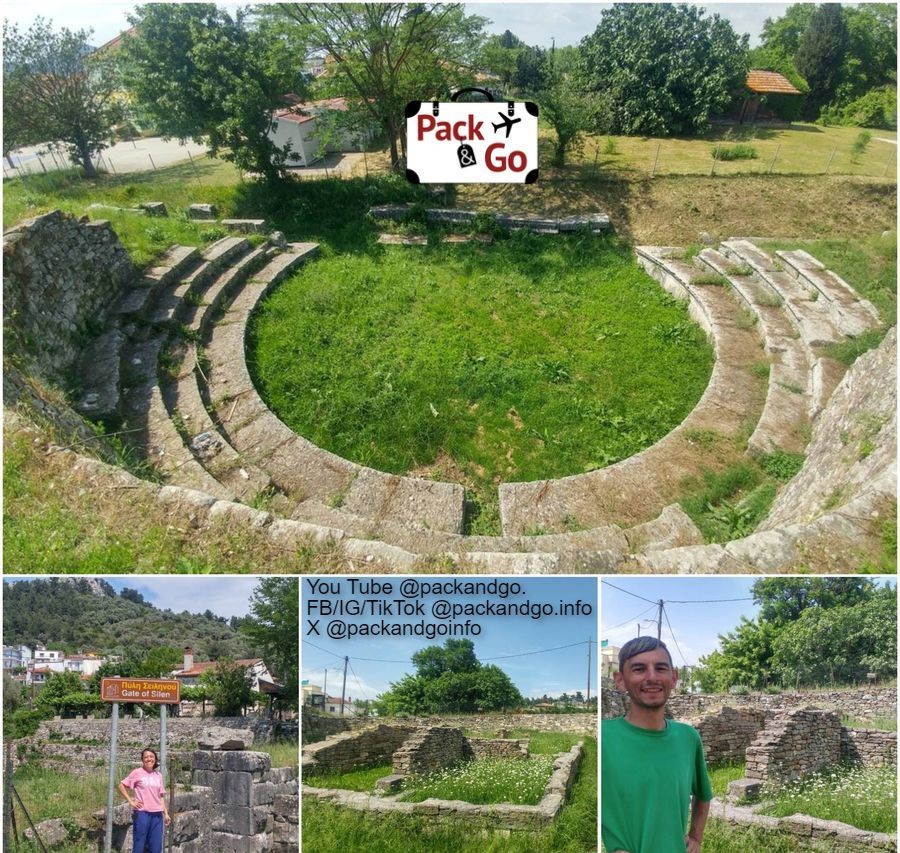
If you are a history enthusiast, visit the tomb of Cassius Gaius Longinus. Cassius, known as Julius Caesar’s archenemy, was a key figure in Roman history. He committed suicide after his army was defeated by Mark Antony. Cassius was buried in 42 B.C. on this island.
Thasos, Greece, museums
Thasos Island’s history, traditions, and heritage is ancient and rich. You can visit the Archangel Monastery, the Archaeological Museum of Thasos, the Folklore Museum of Limenaria, or the Monastery of the Assumption to get a glimpse.
What to visit in Thasos, Greece?
Thasos Greek island, the Northern jewel of the Aegean, welcomes you to explore every town, beach, and hill. What to visit will depend mostly on your personal preferences and the time you have to spend there. We took the scenic ring road and stopped in the following spots.
Thasos town (Limenas)
Arriving from Keramoti port, your direct destination will be the island's capital, Limenas. It is a cute and comfortable town. Within it, modern amenities blend with tradition and history. Restaurants, tasty cuisine, tavernas, fancy beach bars, shops, cafes, archeological ruins, sandy beaches, a vibrant port area, and more, await you! Strolls, complete days on the clear and azure waters of the Aegean Sea, and awesome panoramic views, aren’t you tempted yet?
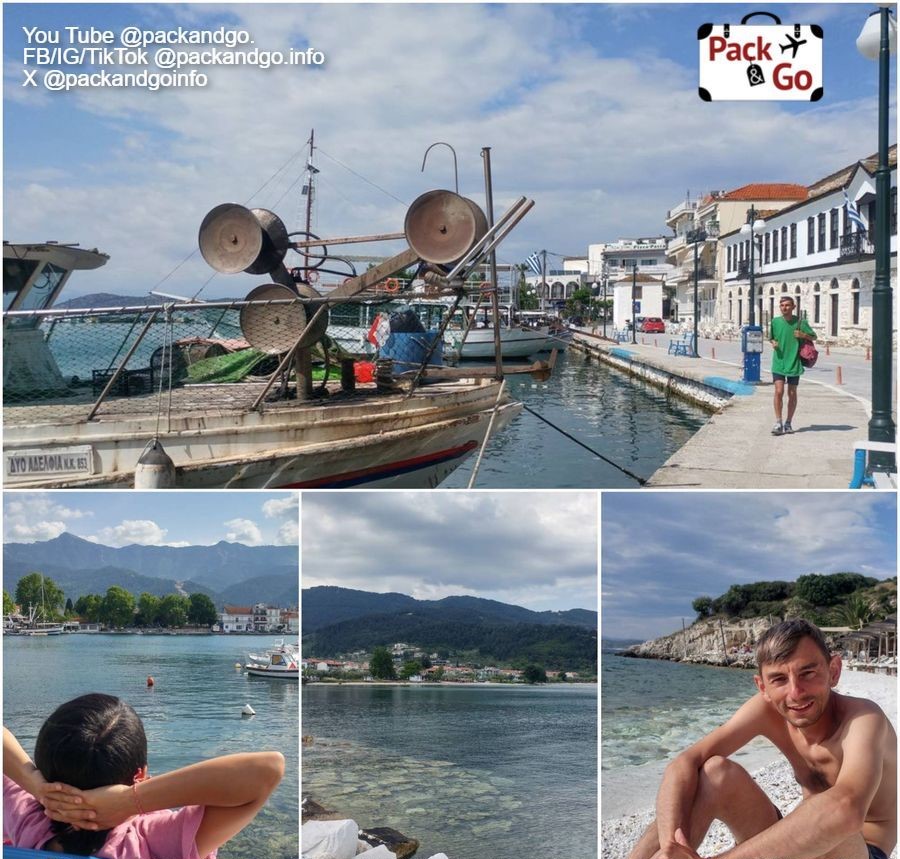
Skala Rachoniou
Skala Rachoniou offers another angle of the stunning Thasos coastline and it is truly a feast for the eyes! It is another great choice for relaxation. All the olive groves surrounding the village add a touch of natural beauty. The local tavernas offer fresh seafood and traditional Greek dishes. Its little port is an opportunity to stroll and feel the locals’ vibe, see the fishermen working, or rent a boat to go around.
You can also visit the church of Saint Paraskevis or explore the nearby Thasos beaches, such as Arriba or Platana.
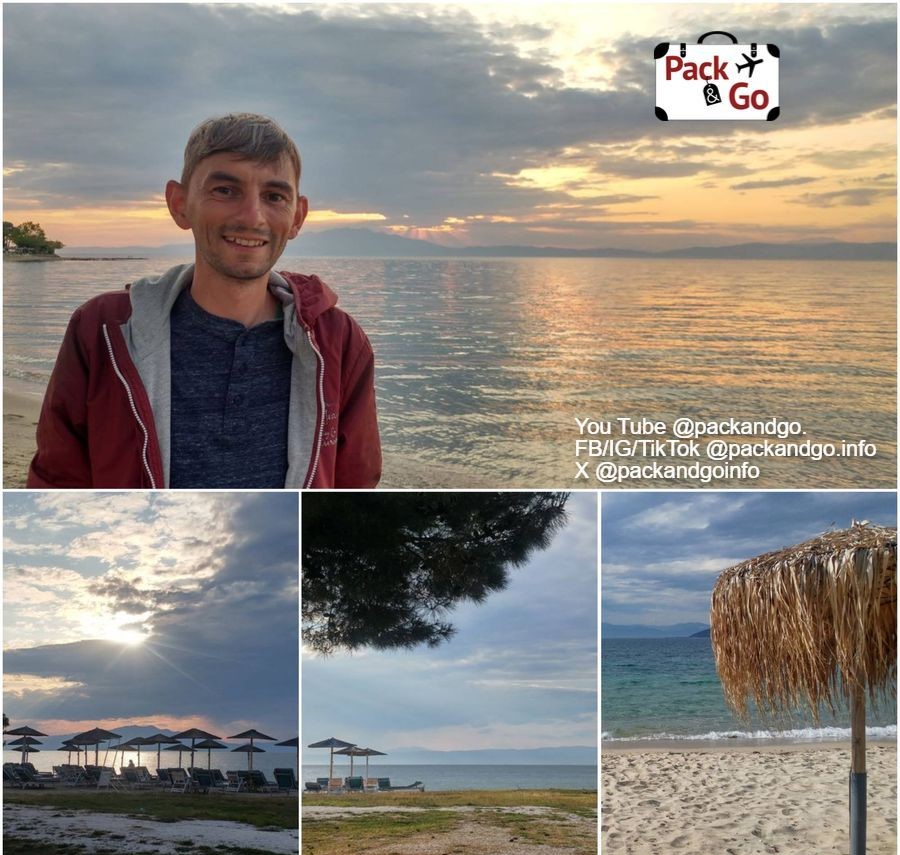
Skala Prinos
Skala Prinos is the second largest port on Thasos Greek island. It also provides ferry connections to the mainland. If you go there, enjoy its long beaches, vibrant market, and the nearby Kalogeriko, an old traditional building hosting cultural events. Accommodation, restaurants, and beach bars, the port town has everything you need for a comfortable stay.
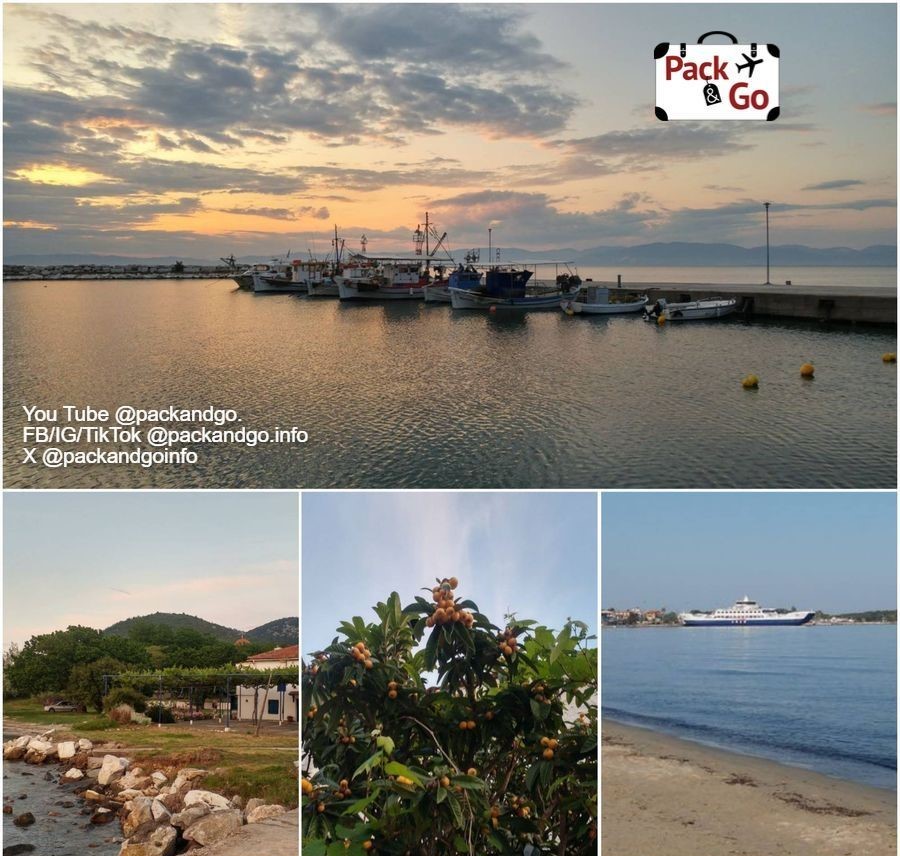
Skala Sotiros
This is a beautiful village known for its picturesque harbor and serene beaches. The more you get away from Limenas, the less packed beaches are. Skala Sotiros was originally a fishing spot. After 1976, it started welcoming tourists attracted by the village's peace and fishing as a leisure activity. There, you can see the oldest olive press of Thasos at the local museum.
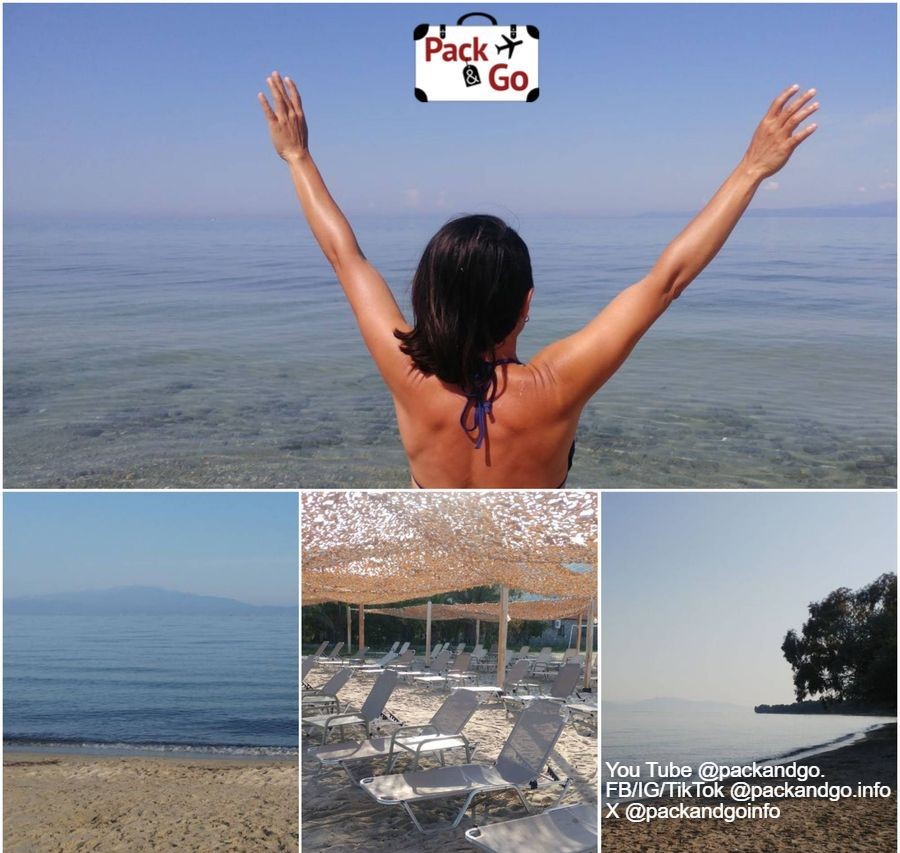
Skala Kallirachis
It is another traditional fishing village located on the western part of the beautiful Thasos coastline. Its quaint streets and friendly locals offer a glimpse into the authentic island lifestyle, with plenty of opportunities for fresh seafood dining. From there, you can see the mainland and some Kavala high peaks.
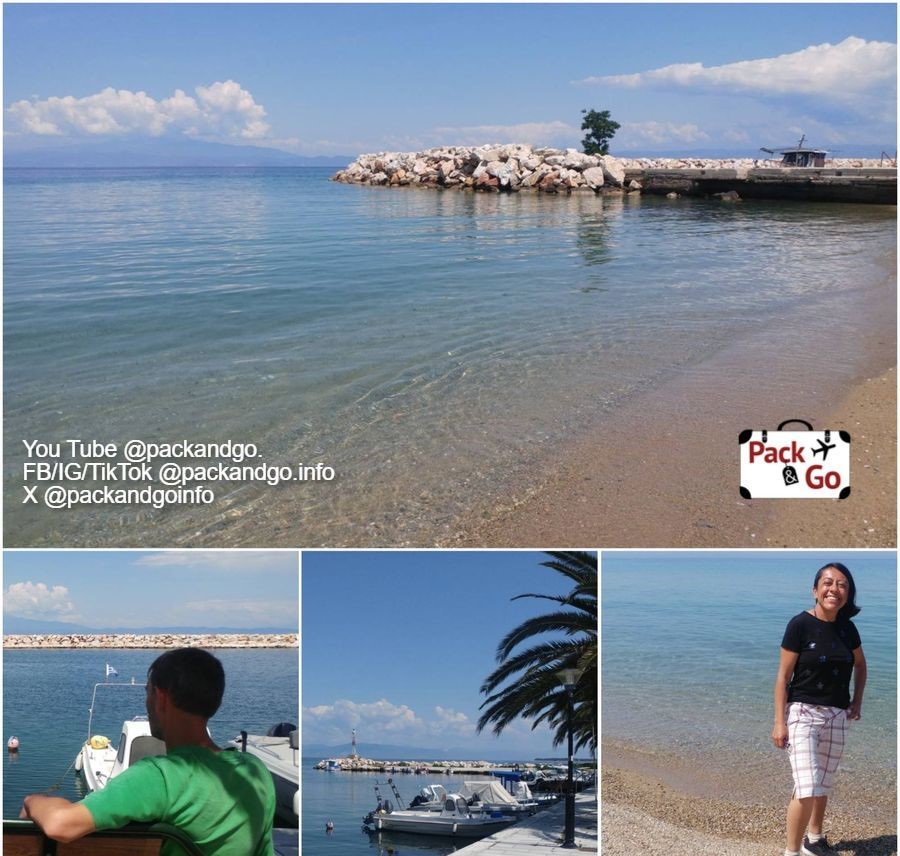
It is a quiet village to stay. Another ideal spot for fishing, exploring its countless calm, beautiful beaches, and spot astonishing sunsets with a cup of wine in your hand, or a cold coffee.
Skala Marion
Welcome to another picturesque village with stunning views of the sea and surrounding cliffs. Its beauty is enhanced by its amphitheater-like construction over a serene creek, where local fishermen dock their boats in a quaint harbor. The village spans three stunning bays, each more captivating than the last, surrounded by beautiful beaches! Sunsets are magical here!
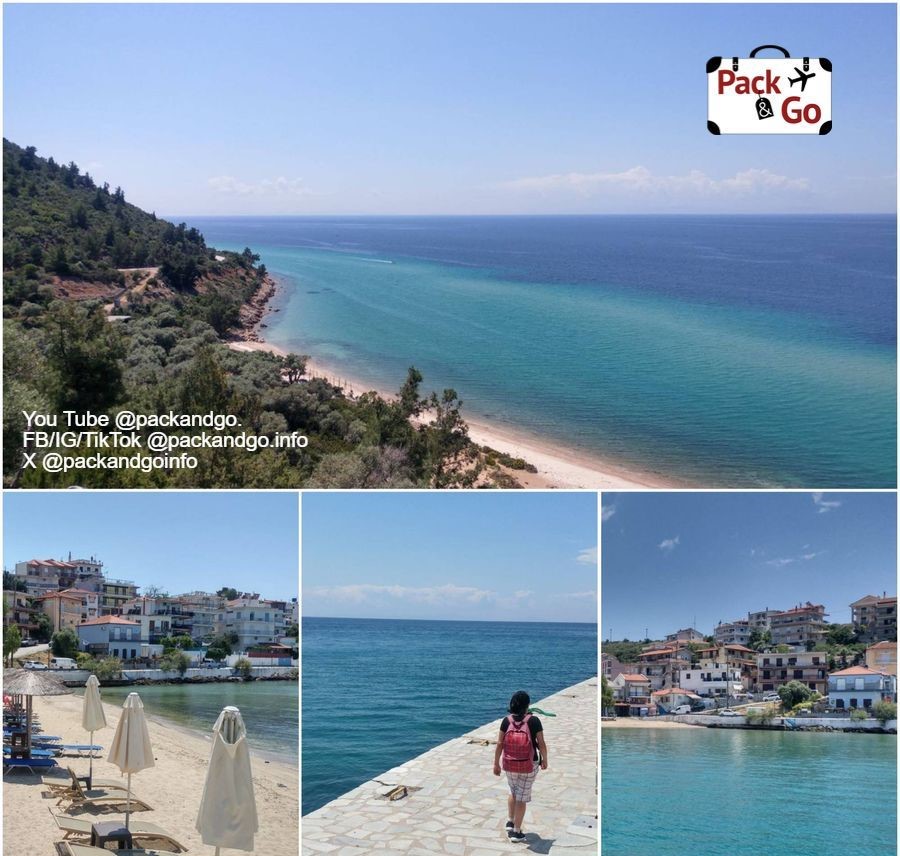
Skala Limenaria
This is a more developed and lively village on Thasos Island. It offers a mix of beautiful beaches, shops, tavernas, and vibrant nightlife. If you want to balance a relaxing stay in a quiet village with a bit of bustle, Limenaria can be that choice!
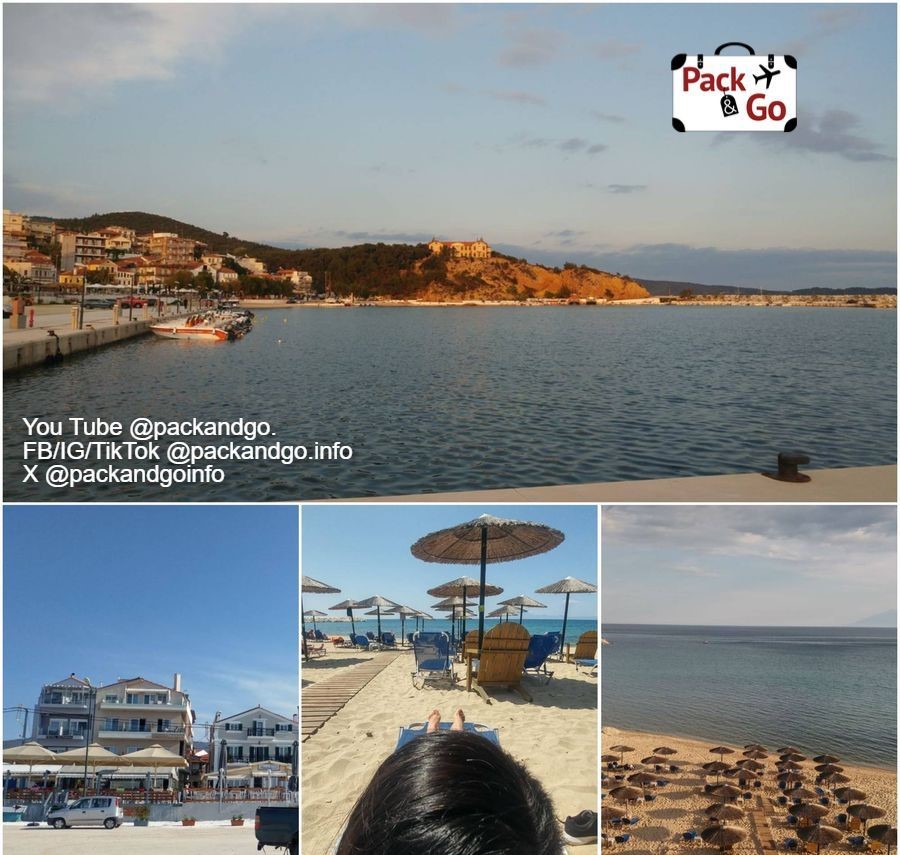
Theologos
Theologos is one of the oldest towns on the island. It was Thassos’ former capital. It is a mountain village famous for its traditional architecture, cobblestone streets, alleys, and rich history. Here, the landscape changes offering variety for restless tourists. The place has hiking routes to explore, all the amenities you need, a Folklore Museum, a view of traditional Thassian houses, and the beautiful Gourna waterfall!
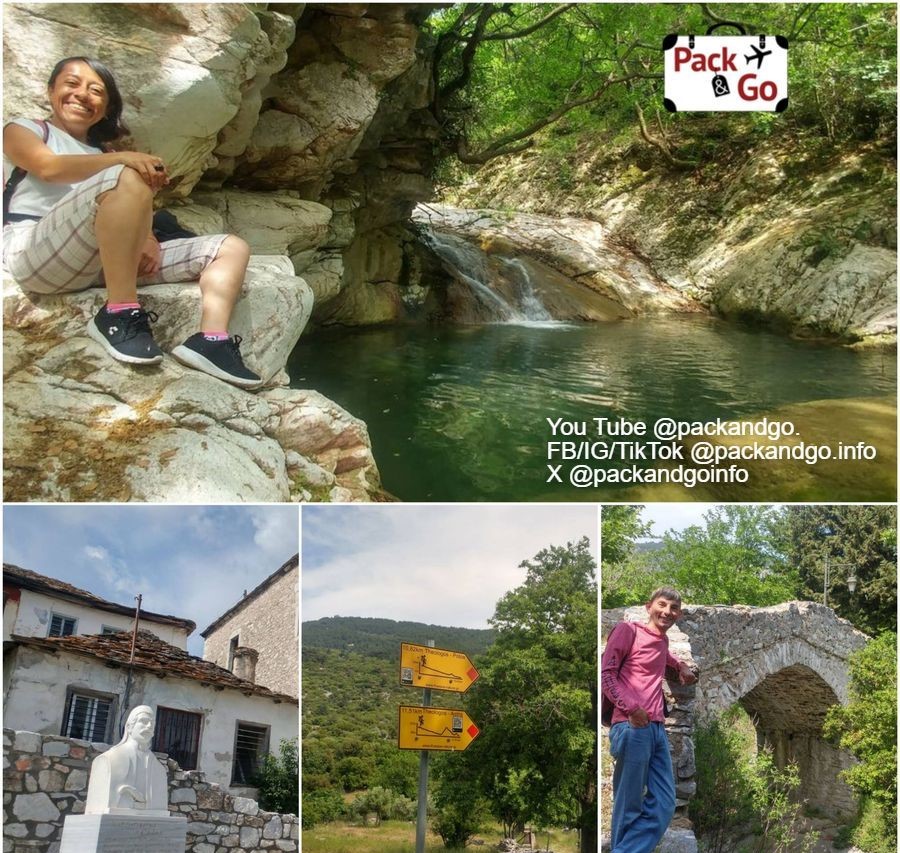
Pefkari
Pefkari is a small resort known for its clear waters and pine-covered surroundings. Its beach is one of our favorites! Tourists visit it to practice water sports and beach activities, but luckily, it was quiet when we were there. Pefkari beach waters are a perfect spot to relax.
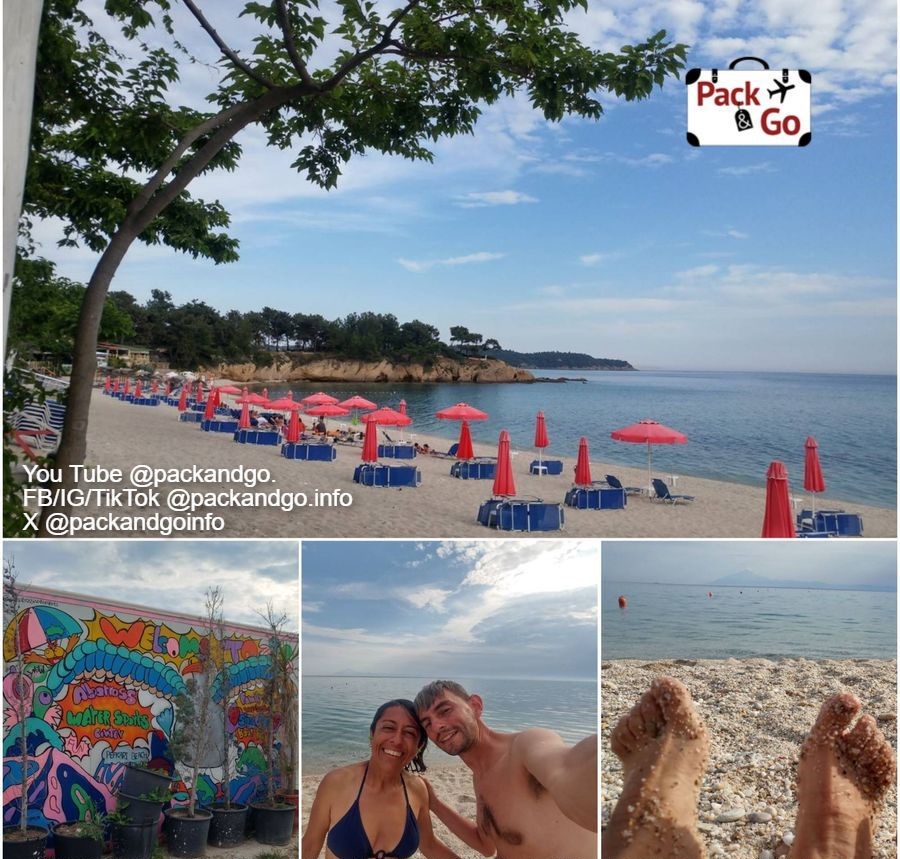
Giola
Giola is a marvelous place you should visit. After walking some meters on hard terrain, you will reach an astonishing natural rock pool known as the "Tear of Aphrodite". It is a unique geological formation.
The striking scenery and the opportunity for cliff diving can be what you need to boost your emotions!
When we arrived, a cool group of Bulgarian tourists were enjoying and encouraging every visitor to cliff diving. It was a very fun experience!
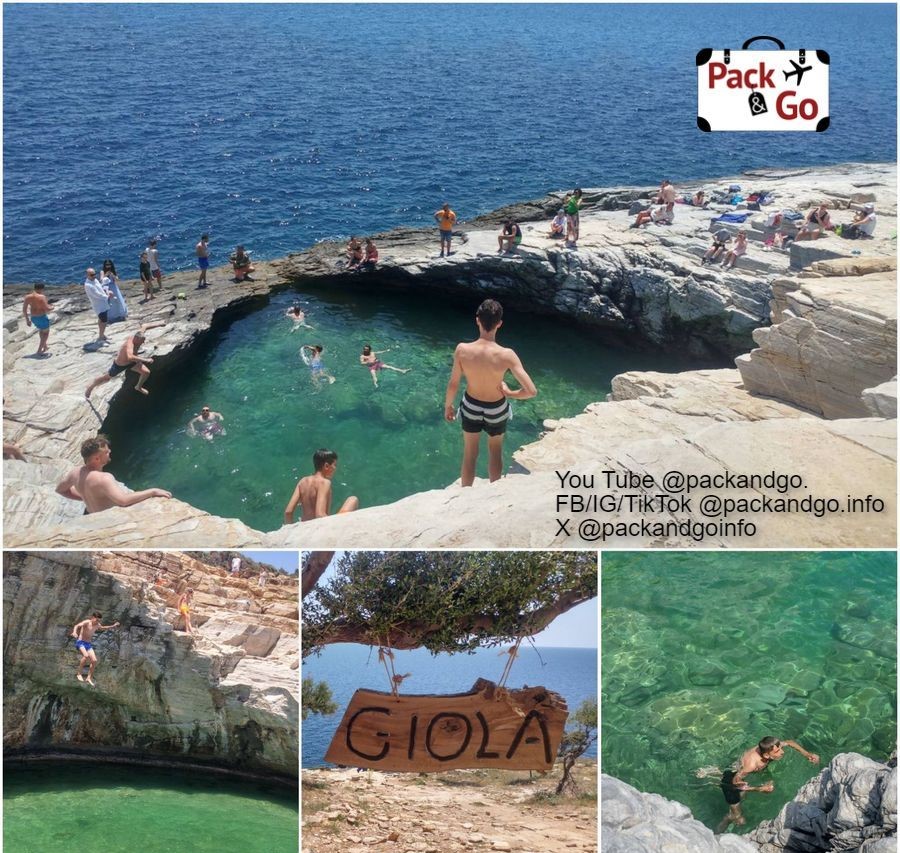
Aliki
It is a great place to explore in Thasos Greek island. It is home to ancient ruins, marble quarries, and two beautiful and serene beaches. It is a special place where history and relaxation beautifully blend.
We walked the narrow path that leads to the windy bay of Aliki, near the archaeological site. It is a pleasant scenic route that takes you to another beautiful beach, and a windy cove, rich in historical and natural beauty. You can shorten the route by going through the gate behind the restaurants, but if you have time, take the long one! You won’t regret it!
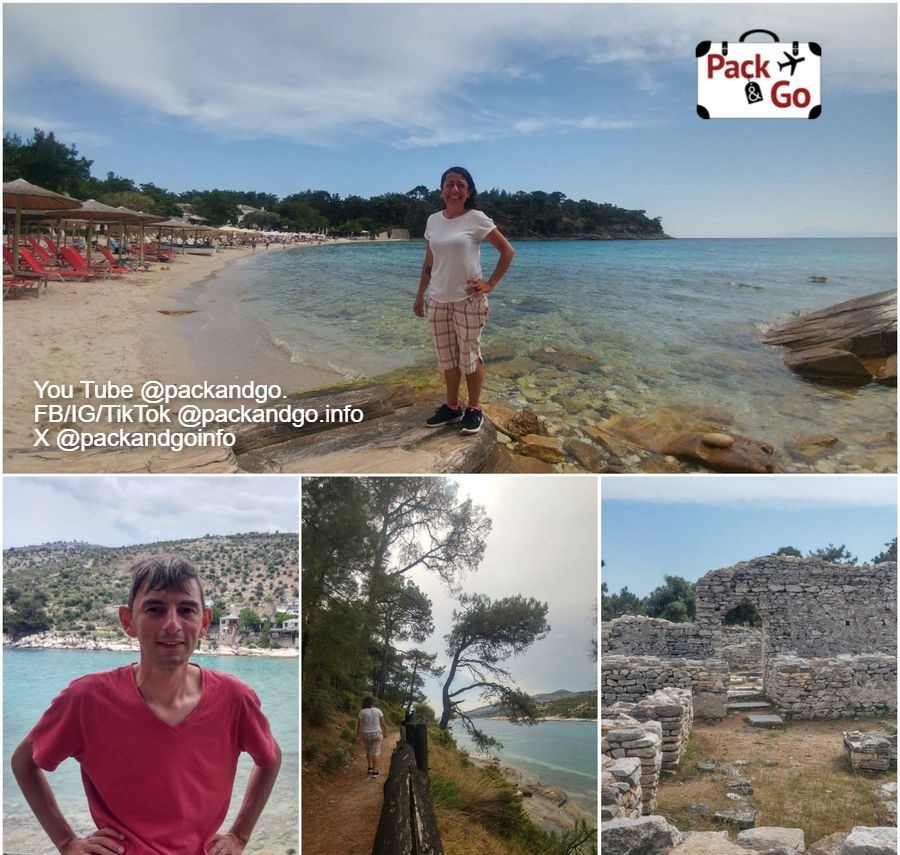
The ancient quarry is located at the southeastern point of the cape. Close by, two temples carved directly into the stone nestled within the holy rocks northeast of the cove. The area between the quarry and the temples served as a bustling transportation and commercial center as early as the 12th century BC. This strategic location facilitated the maritime transport of precious white marble and marble products throughout various empires, from Greek to Byzantine, until the seventh century AD when northern invasions halted its prosperity.
On the eastern side of the cove, shrines dedicated to the gods Dioskourous and Apollo date back to the fifth and sixth centuries BC. These deities, revered for their protection over sailors and their journeys, have left a legacy that includes ruins of one of the shrines beside the sea.
Skala Potamia
We arrived in a traditional and beautiful village with great views of the sea and Mount Ipsarion. It is a beachfront village located on the Thasos' eastern coast. There is everything here: traditional tavernas, shops, cafes, scenic hiking trails, natural attractions, and awesome beaches such as the famous Golden Beach. It is a two-kilometer beach that starts in Skala Potamia spanning all along the bay.
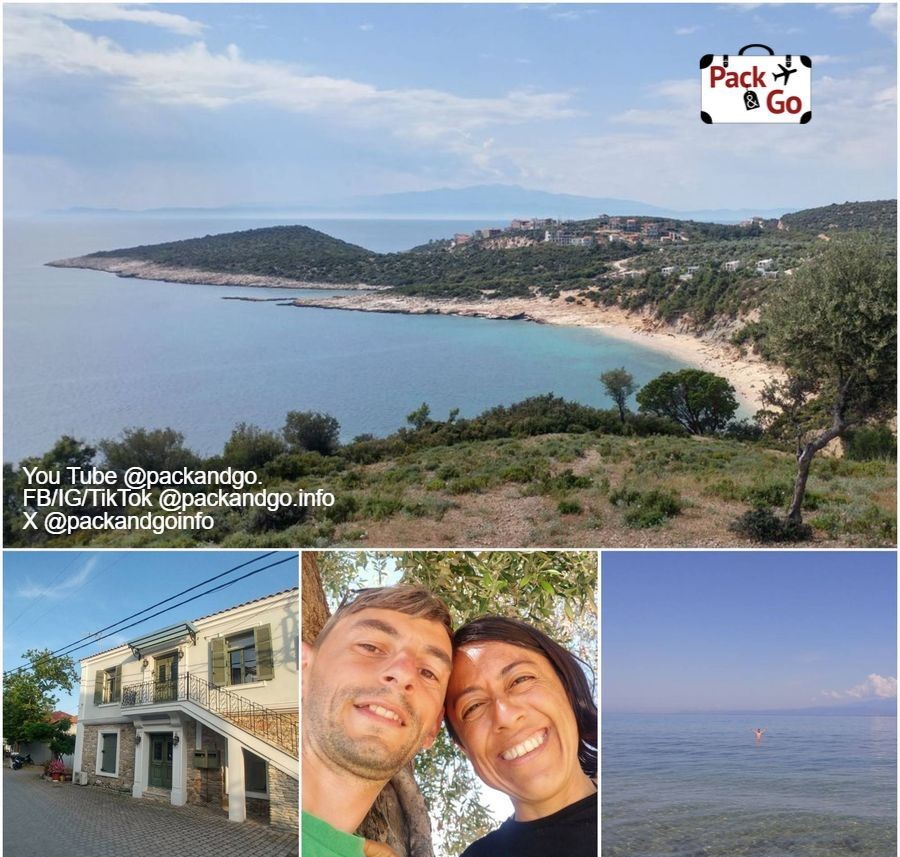
Panagia
Panagia is on the northern Thasos coast. Its altitude is 300 meters and it is close to the famous Golden Beach, the Ipsarion Mount, and only eight kilometers away from Limenas, Thasos capital. Its location makes it ideal for many tourists who want to be close to the attractions but in a more authentic and quiet Greek village. It is, together with Theologos, one of the oldest villages on the island. Enjoy its iconic traditional stone houses and charming narrow streets.
History enthusiasts, nature lovers, and beachgoers will love Panagia’s vibe. The village’s most important celebrations are Ash Monday (carnival) and the Virgin Mary feast, on the 15th of August.
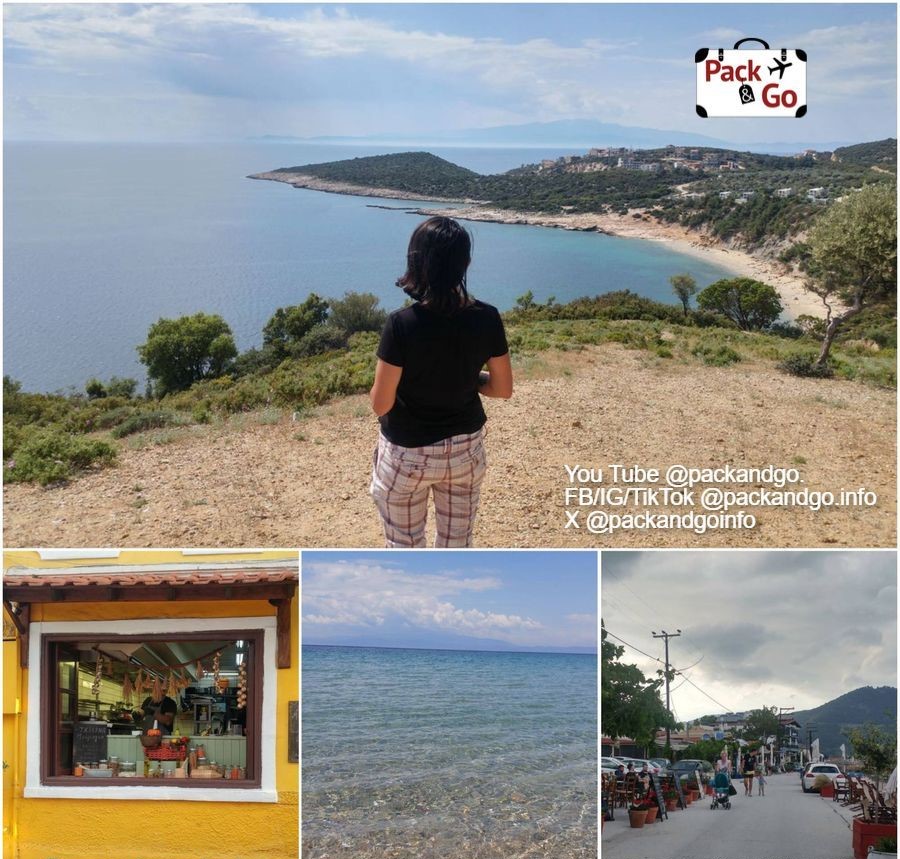
Thasos Marble Beach
We closed our exploration on the Greek island, visiting a stunning beauty, Thasos Marble Beach. In this Thasos beach, rather than sand, you will walk on a smooth surface of white marble pebbles. The effect marble pebbles create is wonderful. The sea turns into a unique turquoise color you can’t miss. The shallow, calm, and crystalline waters are everything you need; a feast for your senses!
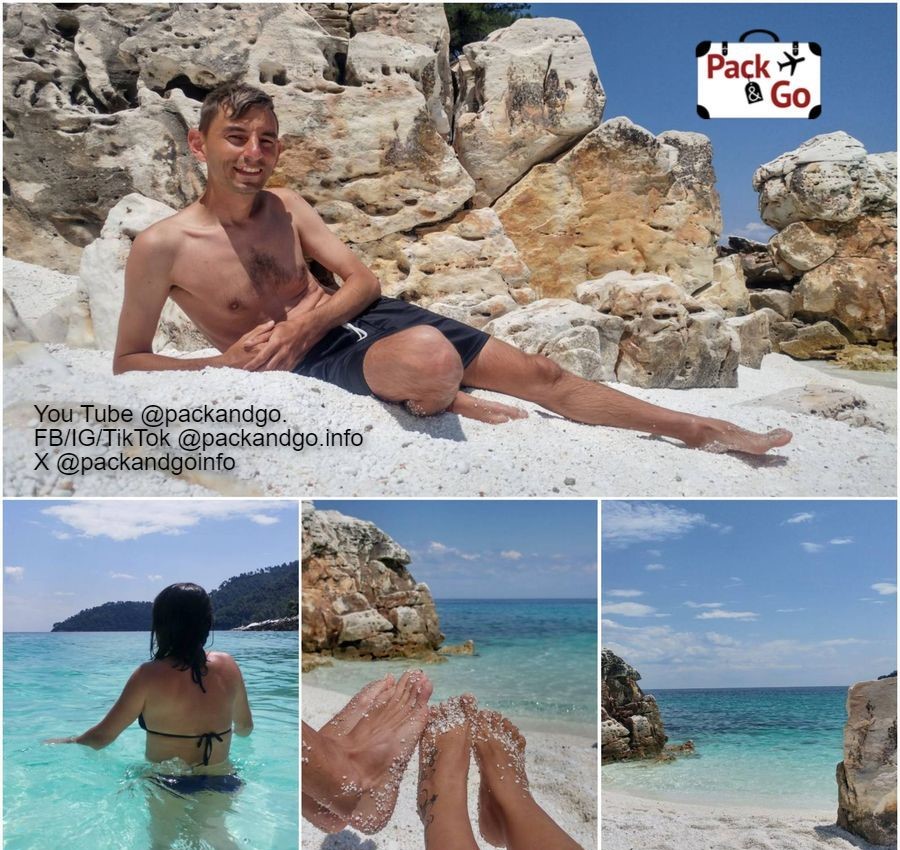
Conclusion
About Thasos, we still recommend: Don't fall for the hype, get your own opinion! Pack and Go! For us, exploring the northern Aegean’s Jewel has been an absolute pleasure! The island is a treasure that offers historical richness, natural beauty, delicious food and drinks, charming villages, scenic paths, stunning views, and vibrant culture. It has something for every type of traveler! It is not an exaggeration, this island is truly a jewel!
We don’t feel like leaving Thasos, Greece. We know from now, how much we will miss our walkings breathing the scent of the Aegean Sea mingled with local cuisine. There is a magic simplicity in this island full of natural beauty that gets strongly into your senses.
| Follow PackAndGo.info at: | |
| YouTube | @packandgo. |
| @packandgo.info | |
| X | @packandgoinfo |
| Bluesky | |
| @packandgo.info | |
| TikTok | @packandgo.info |
It is official, Fanari has been occupied by Bulgaria!
Why do young people dislike Kavala?
Please, do not visit the beaches near Kavala City!
Alexandroupolis: the European city the Turkish dreamed of!
- Details
- Written by: Gianna Esquivel
- Hits: 541
Alexandroupolis is a Thracian city that has been the object of lust of all its neighbors. Fights between Greece, Türkiye (Turkey), and Bulgaria still echo in the background. Finally, decades after the fights, this port has opened its harbor for everybody, the neighbors included. What is there to see? Is it really worth all the fights? Are we going to like it? After being mostly in quiet towns and beaches during this trip, we don't know. Alexandroupolis is a city with all the hustle and bustle.
Our time exploring Greek lands is almost over, so let's not waste a second! Come with us to explore Alexandroupolis! Here we go!
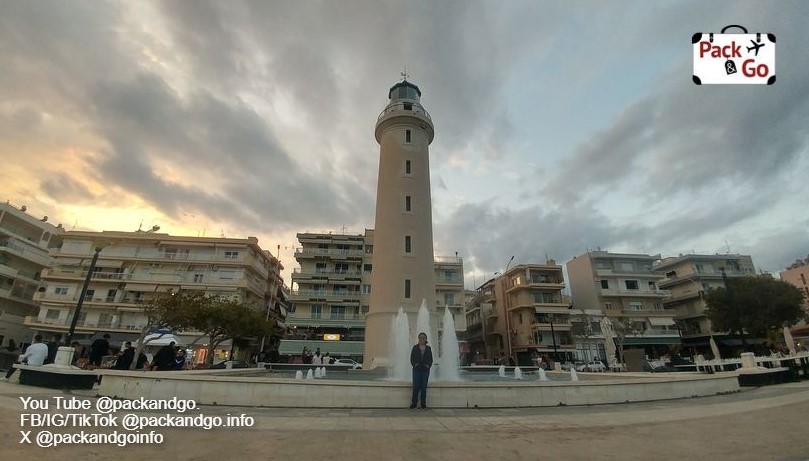
Where is Alexandroupolis?
Alexandroupolis, in northeastern Greece, is situated along the Aegean Sea in the region of Thrace, close to the borders with Türkiye and Bulgaria. Alexandroupolis serves as the capital of the Evros region in Thrace. Its strategic location at the intersection of Europe and Asia imbues the city with a unique charm, blending seaside tranquility with historical significance.
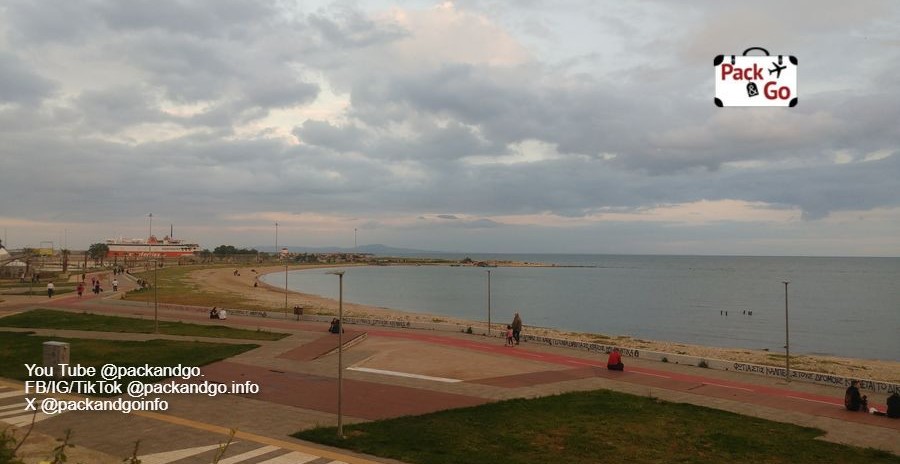
Based on Google’s calculations, Alexandroupolis is about:
- 14.5 km west of the delta of the Evros.
- 76.4 km (60 min) from the Bulgarian border Makaza, via Egnatia Odos/A2/E90 and A23.
- 134 km (1 hr 44 min) from the Turkish border Pazarkule, via E85/EO51.
- 321 km (4 hrs) from Thessaloniki via Egnatia Odos/A2/E90.
- 864 km (9 hr 15 min) from Athens, via Egnatia Odos/A2/E90.
| Follow PackAndGo.info at: | |
| YouTube | @packandgo. |
| @packandgo.info | |
| X | @packandgoinfo |
| Bluesky | @packandgo.bsky.social |
| @packandgo.info | |
| TikTok | @packandgo.info |
How to reach Alexandroupolis?
Getting to Alexandroupolis is straightforward. The city is well-connected by road, air, train, etc.
- Car. Which road to take will depend on where you are coming from. For instance, driving along the Egnatia Odos highway provides a quick route from Thessaloniki.
- Air. Alexandroupolis has an International Airport, "Dimokritos". You can find flights from Athens and Thessaloniki, making it easily accessible.
- Train. Greece’s railway network links Alexandroupolis to other major cities, offering scenic countryside views.
- Bus. Buses to Alexandroupolis run daily from the main cities in Greece. The bus line KTEL operates in the area. You can even take a bus from neighboring countries Bulgaria or Türkiye (Turkey). For instance, a bus from Plovdiv, Bulgaria to Alexandroupoli is available and takes 14 hr 20 min.
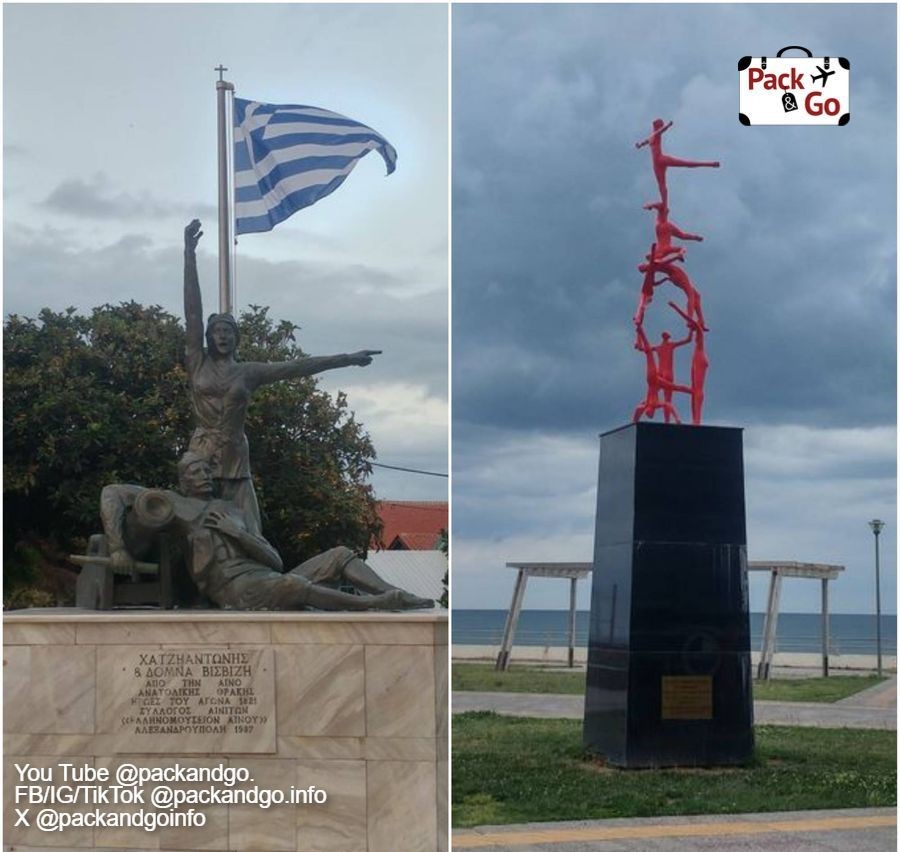
What is the origin of the name Alexandroupolis?
The city was named after King Alexander I of Greece in 1920 to honor his role in the area’s liberation during the Balkan Wars. Before adopting its modern name (Ἀλεξανδρούπολις), it was known as Dedeağaç during Ottoman rule, reflecting its multi-ethnic history.
The history of Alexandroupolis. A city at the crossroads of civilizations
A bit of history is helpful to understand many things you will observe currently in this Greek city.
Strategic location. Alexandroupolis' location at the meeting point of Europe and Asia has shaped its identity as a cultural and strategic hub. Throughout history, its proximity to the Evros River, a natural boundary between Greece and Turkey, has made Alexandroupolis a gateway to the Balkans and Anatolia.
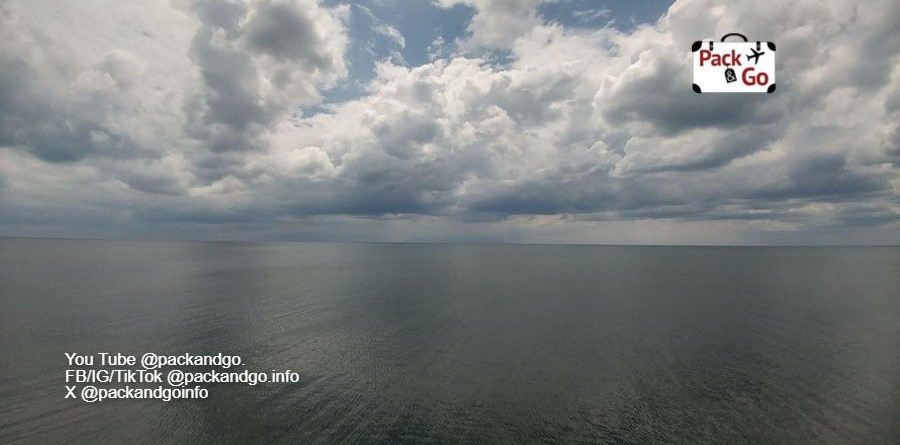
A fishing village becomes a crossroad. Alexandroupolis began as a small fishing village in the early 19th century during the Ottoman era. That original small settlement was known as Dedeağaç and this name refers to "the tree of the elder," symbolizing its local flora. The village’s significance grew with the construction of a railway connecting it to major trade routes in the late 19th century. The Ottoman Empire's development of its port further enhanced its prominence as a trade and military hub.
The Balkan wars and the birth of Alexandroupolis. Following the First Balkan War (1912-1913), control of the area shifted frequently between Bulgaria, Greece, and Turkey. The Treaty of Bucharest (1913) temporarily placed Alexandroupolis under Bulgarian control. However, World War I and subsequent treaties, including the Treaty of Lausanne (1923), solidified its status as part of modern Greece.
The city was renamed Alexandroupolis in 1920 in honor of King Alexander I of Greece, commemorating his visit and the incorporation of the area into Greek territory.
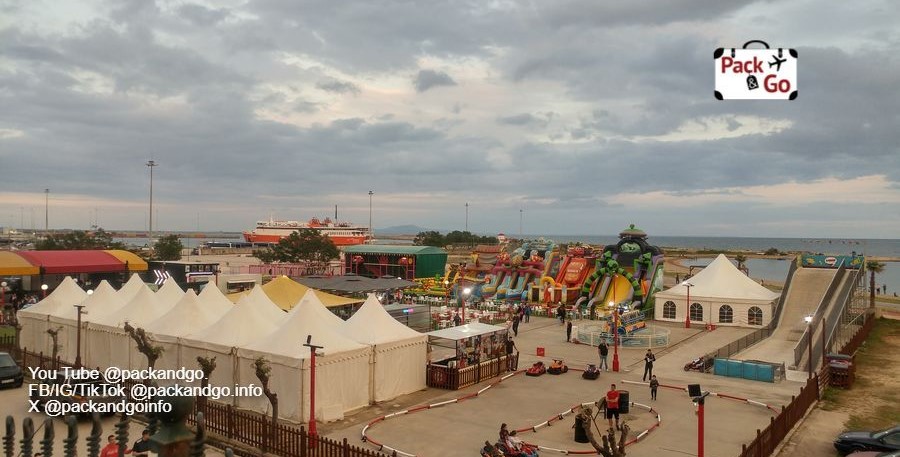
A city geopolitically defined. As you can see now, the geopolitical location of Alexandroupolis has made it a focal point in regional politics. During World War II, the city faced occupation by both Axis and Allied forces. Post-war, its significance grew due to the Cold War, as Greece’s position in NATO heightened Alexandroupolis’ role as a military and logistical center.
In the contemporary era, Alexandroupolis remains a vital link between the Eastern Mediterranean and the Balkans. Its port, railway, and highways connect Greece to Turkey and Bulgaria, playing a key role in trade, energy transport, and regional stability.
Alexandroupolis today. The city blends Thracian, Ottoman, and modern Greek influences. Its ethnological museums, Byzantine-era churches, and proximity to natural reserves, such as the Dadia Forest, showcase its rich heritage. The local economy thrives on fishing, trade, and tourism, while its modern port serves as a gateway for energy resources and goods flowing between Europe and Asia.
What to do in Alexandroupolis?
For us, the city is nice and comfortable but not spectacular. However, it definitely has options to enjoy your vacation. Here you have our favorite things to do and visit in Alexandroupolis. The following options are within its urban limits, so you can comfortably try them all without leaving the city.
Visit the lighthouse
Undoubtedly, the Alexandroupolis Lighthouse is a city landmark you should meet. It is impossible not to see it! It is one of the tallest in Greece and offers stunning panoramic views of the coastline and surrounding landscape. This historic lighthouse (Pharos) has been guiding ships since 1880. It will cross your path every time you go for a cool walk by the sea or to the City Center.
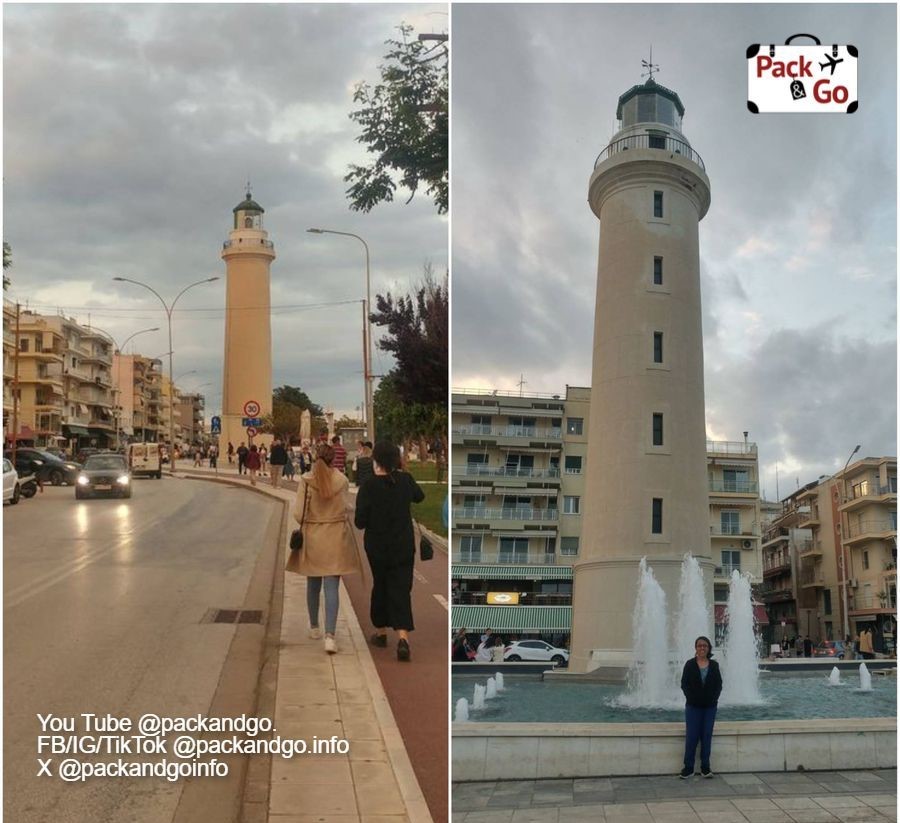
Stroll through the City Center and the Sofy’s Square
The city’s center is not spectacular, but it is close and easy to explore. The first half of the day, this strolling can be a relaxing experience. During the afternoon, the vibe changes a lot. Big waves of young folks arrive at the party clubs that already await them with loud music and neon lights that announce a huge party night. We won’t hide it, we are not into clubs and crazy parties anymore. It was a bit too much for us. Exploring Sofy’s Square was ok, with its cafes, shops, and neoclassical architecture. A visit to the Ethnological Museum of Thrace could be a good idea to get a clearer insight into the region’s history and culture.
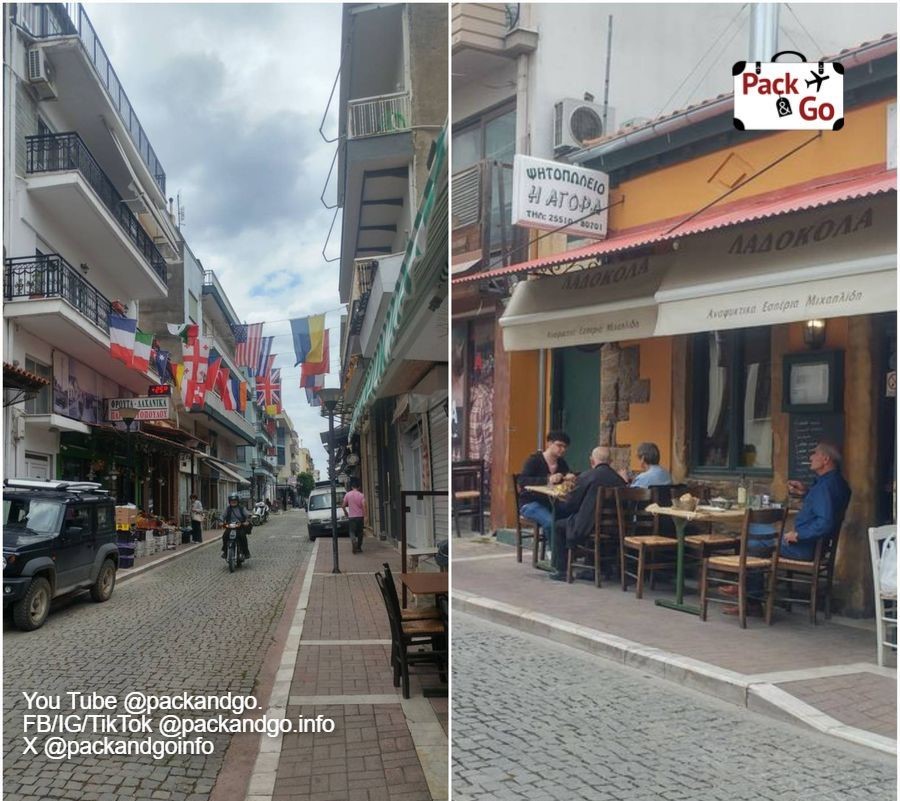
Enjoy local cuisine
There are many local taverns for you to taste the flavors of Thrace, especially the fresh seafood dishes like grilled fish, kavourmas (originally Ottoman but now considered the local sausage), and bougatsa (a sweet pastry). Fun fact, as a result of Alexandroupoli’s proximity to Türkiye, you will find here Turkish kebabs and kavourmas competing vs. the Greek gyros and souvlaki. Not bad for tourists who already can have a tiny sample of the varied and very delicious Turkish food. If it is about food, this area is a paradise for your belly!
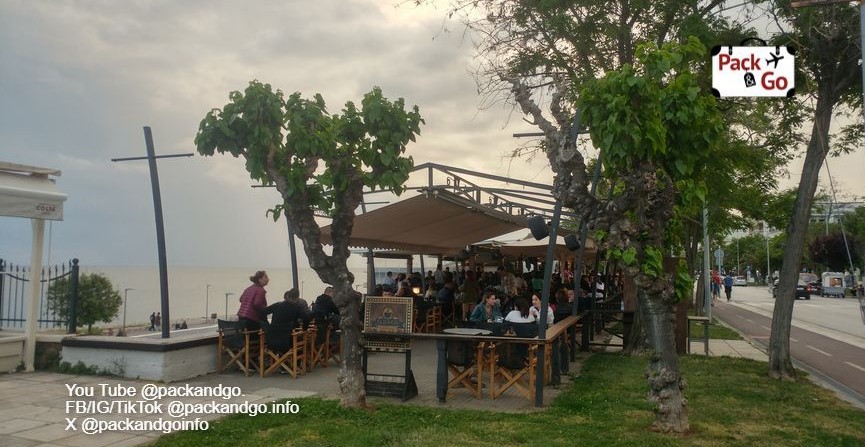
Bulgaria, Türkiye, and Greece have a variety of astonishing ingredients and dishes! There is also a lot of controversy about the origin of some dishes. Food is a massive pleasure and a hot topic too! Hahaha Anyway, let’s focus again on Greece! We've talked about Greek cuisine at every stop on this trip. You can check our previous articles for more Thracian taste.
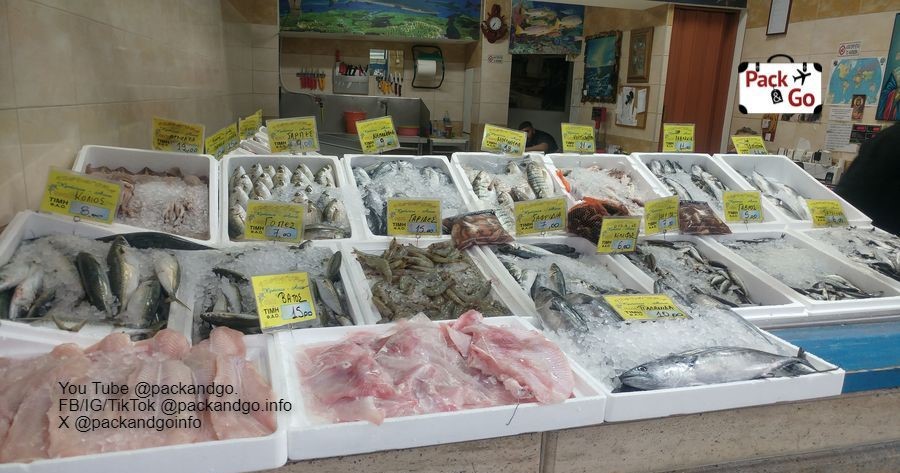
Relax on the beaches
The Aegean Sea is big and generous, so Alexandroupolis also enjoys and offers clear waters for swimming and relaxing. Variety suits all tastes, you can find organized beach clubs with sunbeds and bars or more secluded stretches of golden sand. The closer to the city, the beaches are more beach club and urban style. These were not our favorites. The further you go, you will find quieter beaches. With a bit of luck, they will be only for you (depending on the season you go)!

Perhaps the first recommendation you will get is Nea Chili Beach which is a short distance (west) from the city center. From the Alexandroupolis lighthouse to there it takes a twelve-minute drive (4.9 km). Makri Beach is another popular choice and it is 12.1 km (21 min) away.
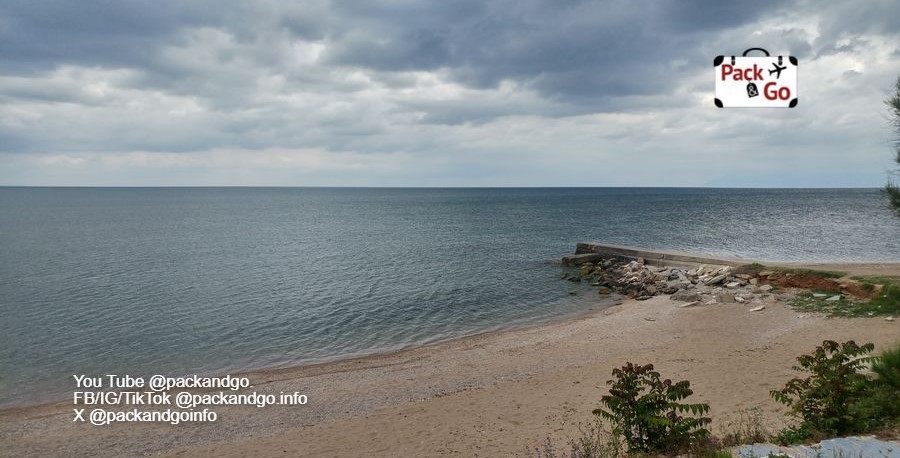
Urban beaches
Alexandroupolis is a city with all the comforts, the hustle and bustle. Normal! However, that definitely impacts the environment of its urban beaches. For instance, its City Beach is well-maintained and ideal for those who want to enjoy the sea without leaving the city. It's easily accessible and offers sunbeds, umbrellas, and nearby cafes. However, it is an urban beach. More people are there due to the easy access, the car pollution and city noise can be feelable in moments of high traffic. For us, it is not the best beach at all and it is not a fair reference to judge Greek beaches. We enjoyed it as a part of our daily walks, but to swim and spend the day we preferred further choices. We know, every traveler has specific preferences, so share with us your opinion, please!
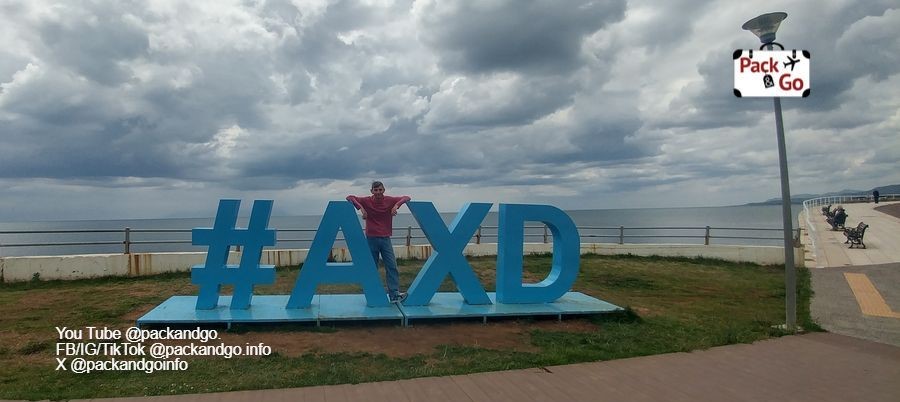
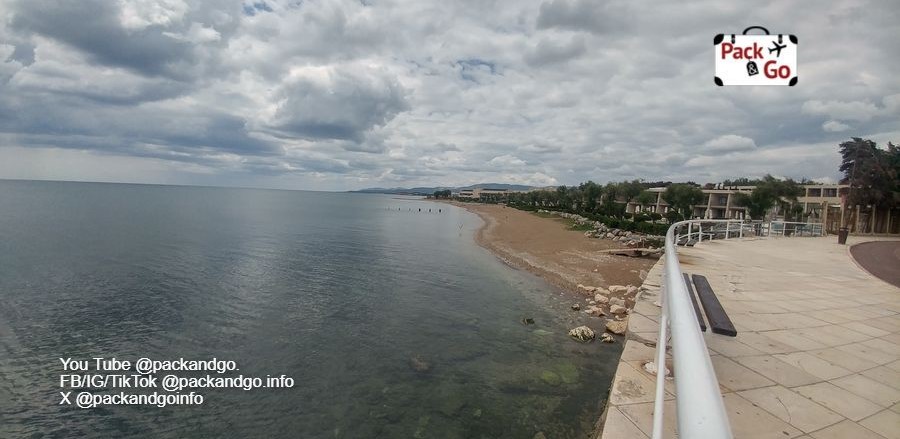
Promenade walk along the waterfront
The city's waterfront is calm during the day and lively in the evenings. A walk along the promenade is perfect to start or finish your day. It offers a mix of sea views, street performers, bars, and restaurants.
Proskopon Park
This is a simple and quiet green space ideal for relaxing. Its location near the seafront makes it a good spot for enjoying the city’s ambiance.
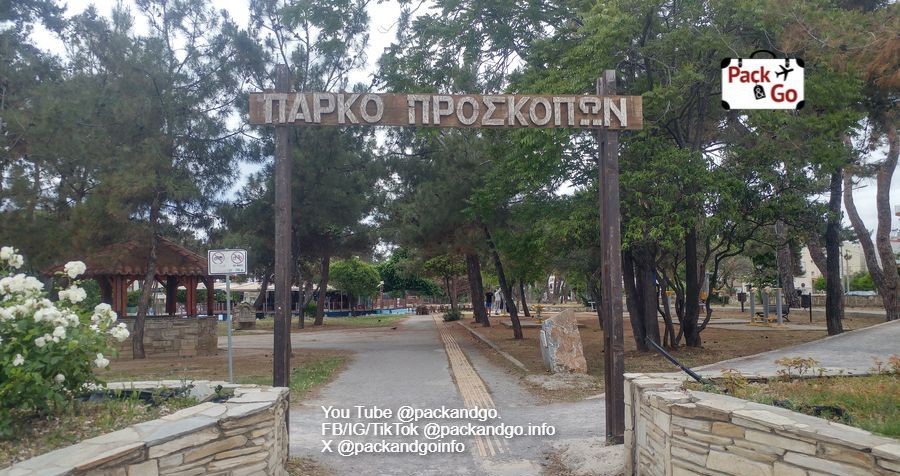
Enjoy the Municipal Park (Dimotiko Parko)
Parks and open spaces are essential for us. We walked around this green and necessary oasis in the city center and had a picnic there. We were not the only, this park is a choice for leisurely walks and picnics and it is nice to see others enjoying the space too. It also has a playground.
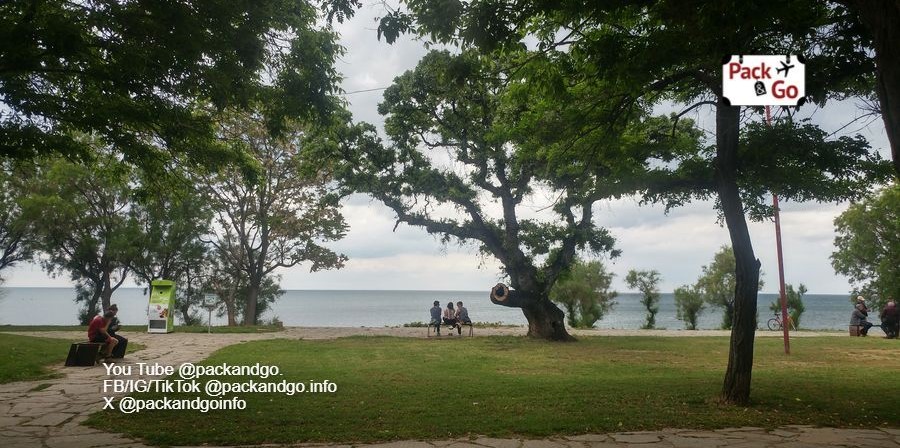
Go shopping on Dimokratias Avenue
This is considered the city’s main shopping street and it is home to a variety of shops, from boutiques to chain stores. You will find everything from fashion and jewelry to souvenirs here. If you don’t want to buy, it is still a good street to walk and discover different local products.
Cultural events and festivals
We were told by different young guys that Alexandroupolis frequently hosts cultural events, concerts, and festivals. We were not lucky, but check local listings for activities during your visit. You could catch a good concert or festival here!
Visit the Metropolitan Cathedral of Saint Nicholas. If you are into this type of building, this is an Orthodox cathedral, dedicated to the city's patron saint. Its serene atmosphere and intricate interior design make it worth a visit.
Ecclesiastical Museum
If the Metropolitan Cathedral gets you and awakes your curiosity, you can walk a very short distance from there and reach the Ecclesiastical Museum. It houses Byzantine icons, religious artifacts, and other treasures that reflect the area's deep spiritual history.
Natural History Museum
It showcases the region’s biodiversity and geology. We didn’t visit it, but different parents recommended it by saying that the museum is a good attraction for adults but it is a greater entertainment for kids. The natural world can really trap children’s attention. Keep it in mind if you visit Alexandroupolis with your family.
Local art galleries
We found different small art spaces in the city center, featuring works by regional artists and photographers. We did not visit many of these galleries because we prioritized beaches and open spaces.
Ferries from Alexandroupolis
The city links to other destinations via ferries. You can reach the Aegean Islands like Samothraki, Myrina/Limnos, and other destinations.
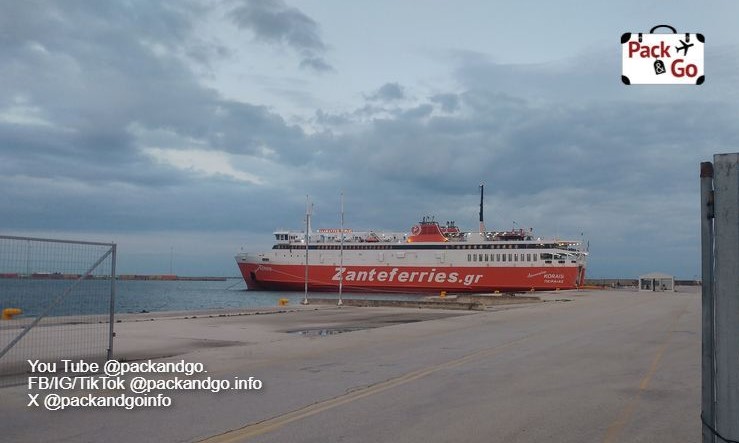
All these options in a city that blends urban comfort with beautiful nature beauty clearly shows why Alexandroupolis is the European city the Turkish dreamed of! And even for Bulgarians, it must have been hard to overcome the loss of this city.
What to visit around Alexandroupolis?
If you stay a week or more in the city and you feel like experiencing a difference, there are some nearby choices you can enjoy. That is not a random event, history told us this place has a really strategic location, and this is true even for tourism!
Thermal Springs of Traianoupolis
Only 14.4 km (20 min) northeast of Alexandroupolis via E85/EO2, Traianoupolis, and its thermal springs awaits you. These thermal baths have been used since Roman times and still, many people visit this place searching for the therapeutic properties of its healing and rejuvenating waters. Rejuvenating sounds good, right? Hahaha The place is nice and the water is warm so relaxation is guaranteed.
Evros Delta National Park
A short drive of 22.0 km southeast (36 min) from Alexandroupolis leads you to the Evros Delta, one of Greece’s most important wetland ecosystems. It’s a paradise for nature lovers, offering boat tours, hiking paths, and the chance to spot hundreds of migratory bird species.
Ancient Mesimvria-Zone
26.4 km (28 min) to the west of Alexandroupolis via Egnatia Odos/A2/E90, you can reach this archaeological site with ruins of a Greco-Roman city. There, you can see remains of public buildings, like theaters, temples (the Sanctuary of Demeter and Apollo's temple), a fortification wall with towers, and baths. Mesimvria-Zone was a colony of Samothrace, built at the end of the 7th century BC, between Maroneia and Alexandroupolis.
| Follow PackAndGo.info at: | |
| YouTube | @packandgo. |
| @packandgo.info | |
| X | @packandgoinfo |
| Bluesky | @packandgo.bsky.social |
| @packandgo.info | |
| TikTok | @packandgo.info |
Explore local villages
You can spend a day visiting nearby villages like Lefkimmi and Soufli. Both are popular for their traditional handicrafts, especially silk weaving, and local cuisine. They are small and charming villages to discover, walk, find a cool hiking trail, and try local food.
Lefkimmi is 52.6 km (45 min) away from Alexandroupolis, direction northeast via Egnatia Odos/A2/E90.
Soufli is 66.8 km (49 min) away from Alexandroupolis, direction northeast via Egnatia Odos/A2/E90 and EO Ardaniou Orestiadas/E85/EO51.
Dadia-Lefkimi-Soufli Forest National Park
If you are a nature enthusiast, the Dadia Forest and its 428,000 acres are for you. Based on Google’s calculations, it is located 70.7 km (one-hour drive) northeast of Alexandroupolis. This national park is home to rare bird species, including the griffon vulture. The forest is perfect for hiking, birdwatching, canoeing, and immersing in the natural beauty of the region. You find easily different hiking trails to lead your exploration. For instance, the orange trail leads you to the Observatory (one hr). Before visiting this forest, check the fire risk index available online (https://civilprotection.gov.gr/en/xartis). Access is closed during the fire prevention period when the fire risk index goes to 3,4 or 5 (May 1st-October 31st).
Should you stay in Alexandroupolis or skip it?
Stay if you pass by! Alexandroupolis is not as developed as Athens or Thessaloniki, but it is the largest city in the Eastern Macedonia region and in Greek Thrace. It is a well-located (seaside) and comfortable city with welcoming locals. It is not spectacular but a nice place to visit and a comfy base for exploring northeastern Greece. Accommodations range from resorts to cozy boutique hotels or apartments, catering to all tastes and budgets. If you love the nightlife, Alexandroupolis has it! Bars and clubs are packed with young people and adults craving for a long party. If you feel enticed by an adventure in the neighboring countries, Bulgaria and Türkiye (Turkey) are just around the corner.
Conclusion
After exploring the city and its surroundings we confirmed it! Alexandroupolis is the European city the Turkish dreamed of. Perhaps not only the Turkish! Geopolitically speaking, it would have been a great victory for Bulgarians, Turks, and anyone else to keep this city within their territory. Finally, Greece won and now, it is a common tourist destination for its neighbors, party animals, and other travelers.
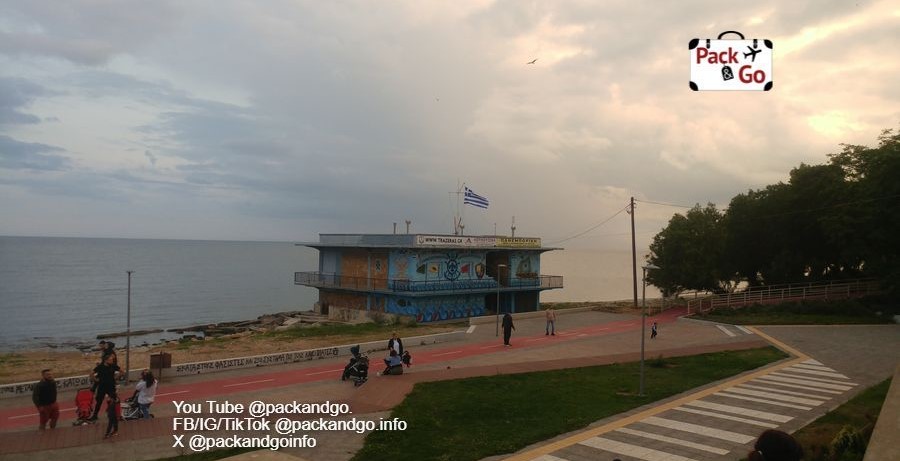
Being objective, Alexandroupolis may not be the first place you think of when planning a trip to Greece. Tourists searching for thrilling archeological sites or developed cities will go directly to Athens or Thessaloniki. Although, it is a city, don’t expect the level of development of the previously mentioned cities. People looking for the best Greek nature paradises for sure will go somewhere else.
However, travelers seeking an off-the-beaten-path experience can really enjoy the difference, simplicity, and proximity with other countries of this city.
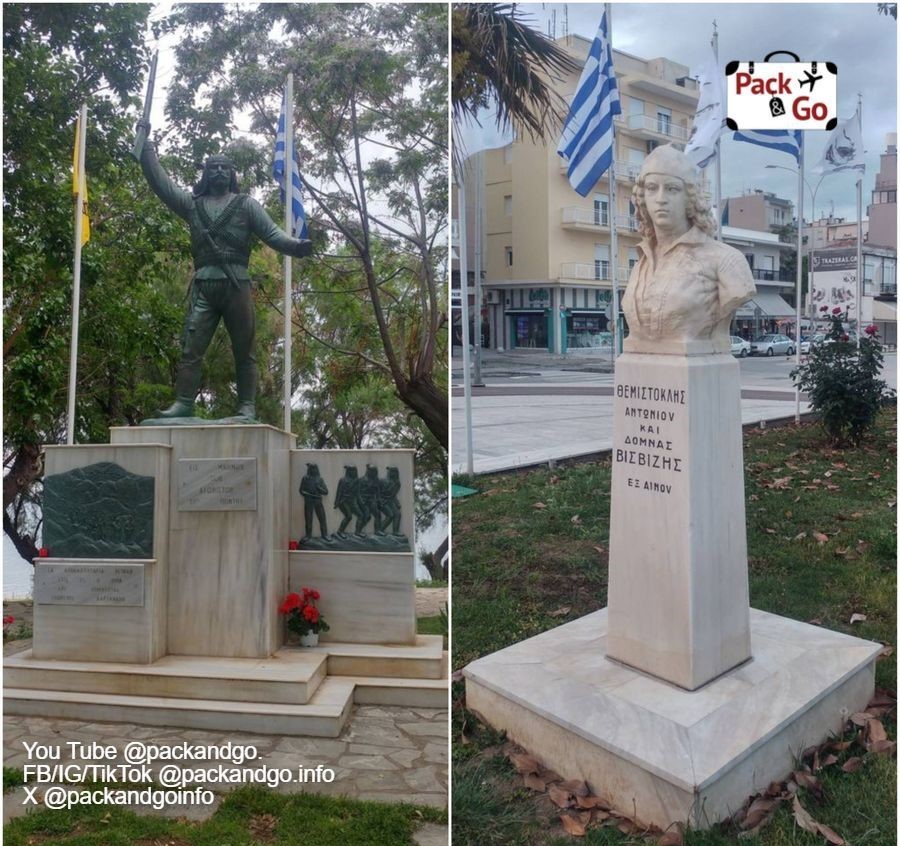
In this sense, the Northern Greece area has been a thrilling discovery for us. If you already visited the very popular spots (Athens, Santorini, Mikonos, Meteora, Rhodes, etc.) where everybody goes, try something different this time! Skipping everybody can lead you to awesome discoveries!
Next stop: Edirne, Türkiye (Turkey)!
You may find interesting to read also:
Keramoti: The Beach Town You’re Not Visiting—And It’s Better Than Santorini!
Thasos, Greece: Don't Fall for the Hype! Read the Truth!
It is official, Fanari has been occupied by Bulgaria!
| Follow PackAndGo.info at: | |
| YouTube | @packandgo. |
| @packandgo.info | |
| X | @packandgoinfo |
| Bluesky | @packandgo.bsky.social |
| @packandgo.info | |
| TikTok | @packandgo.info |
Page 5 of 6
